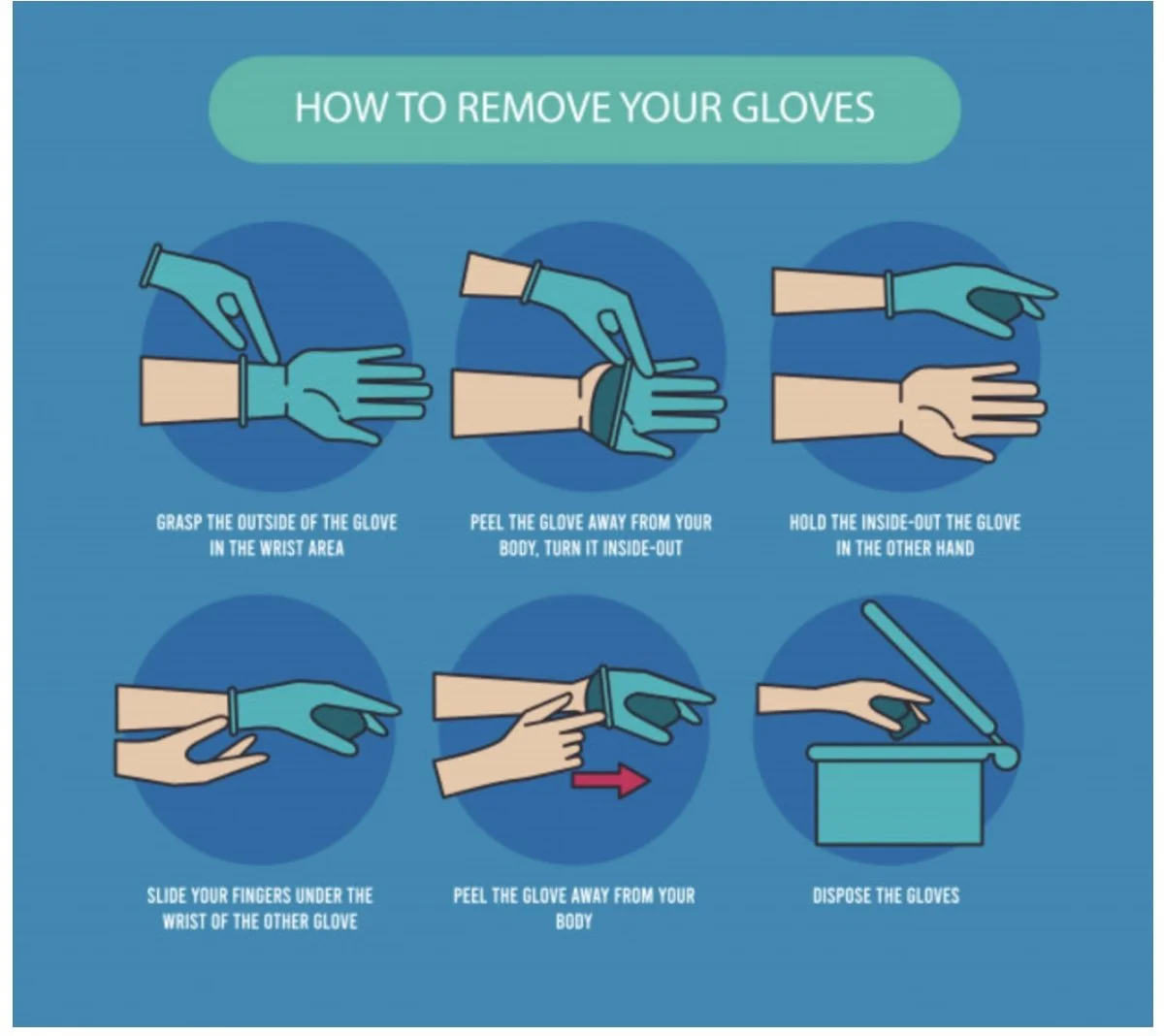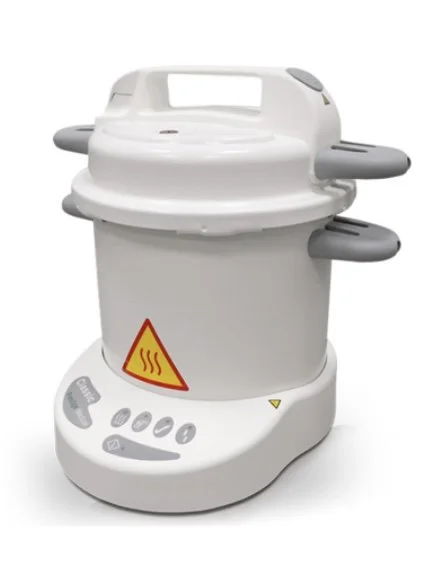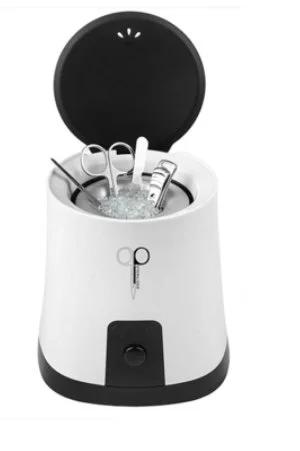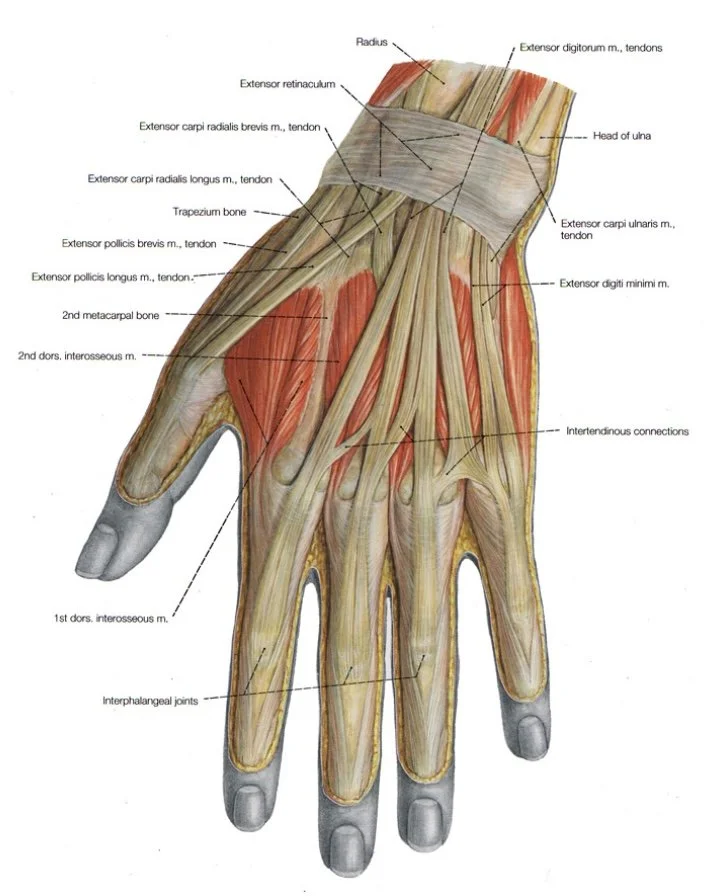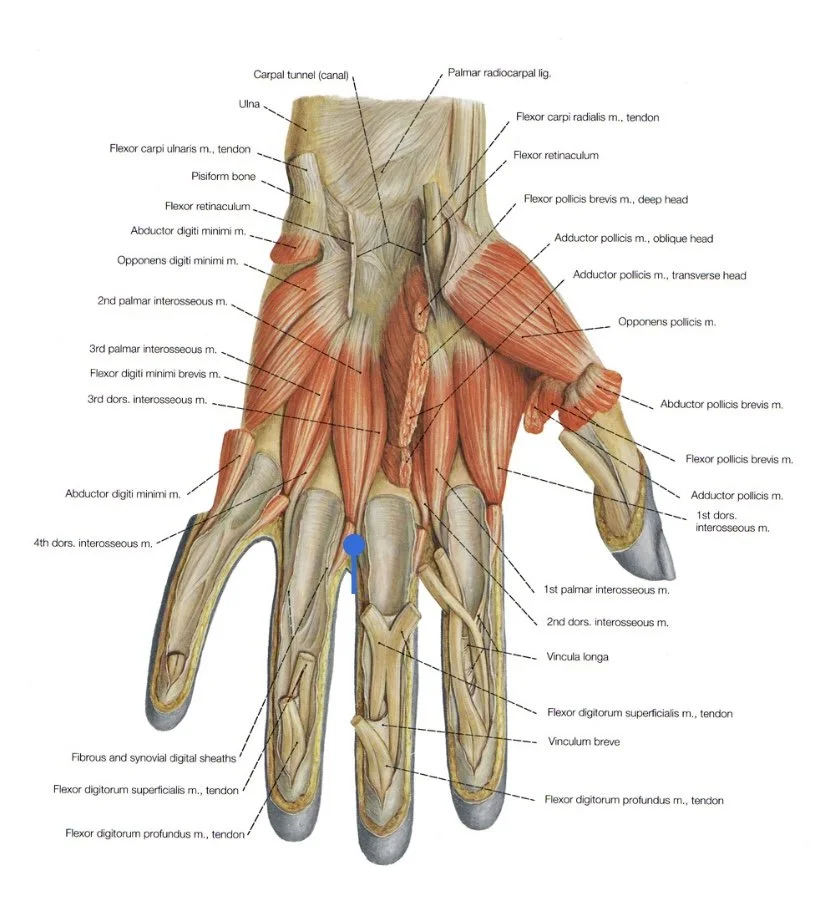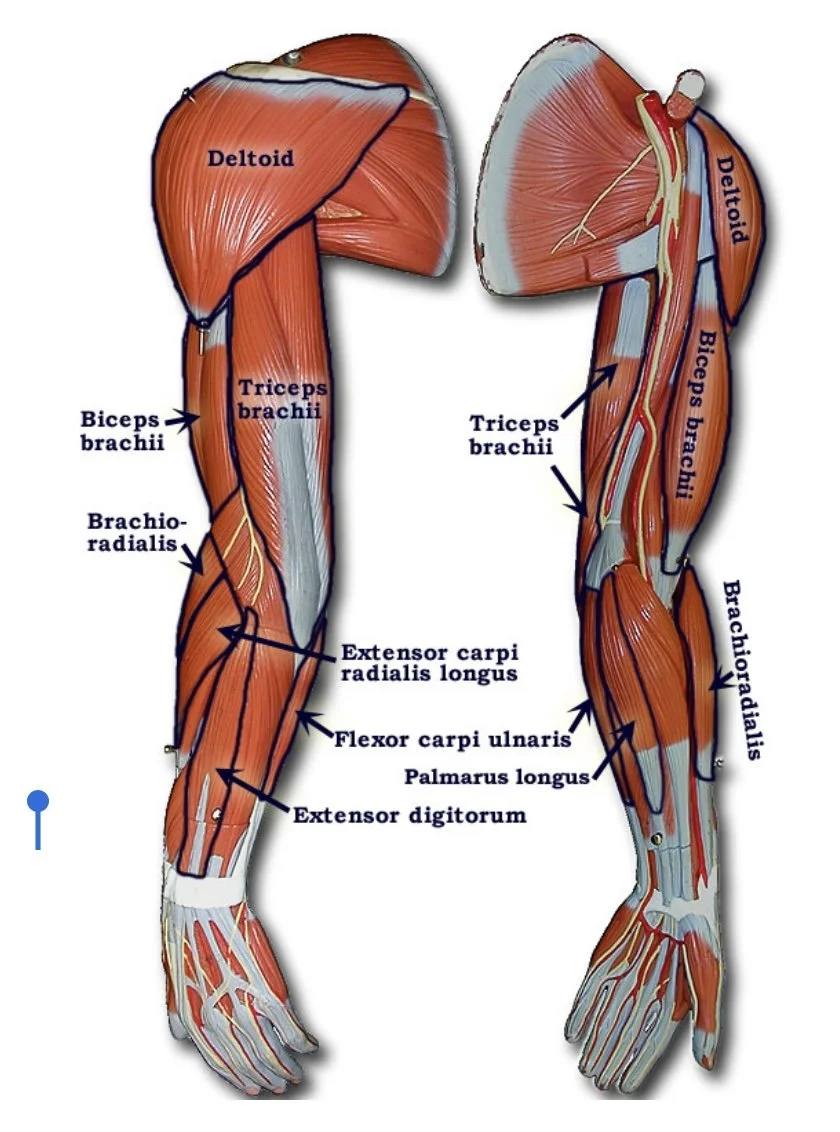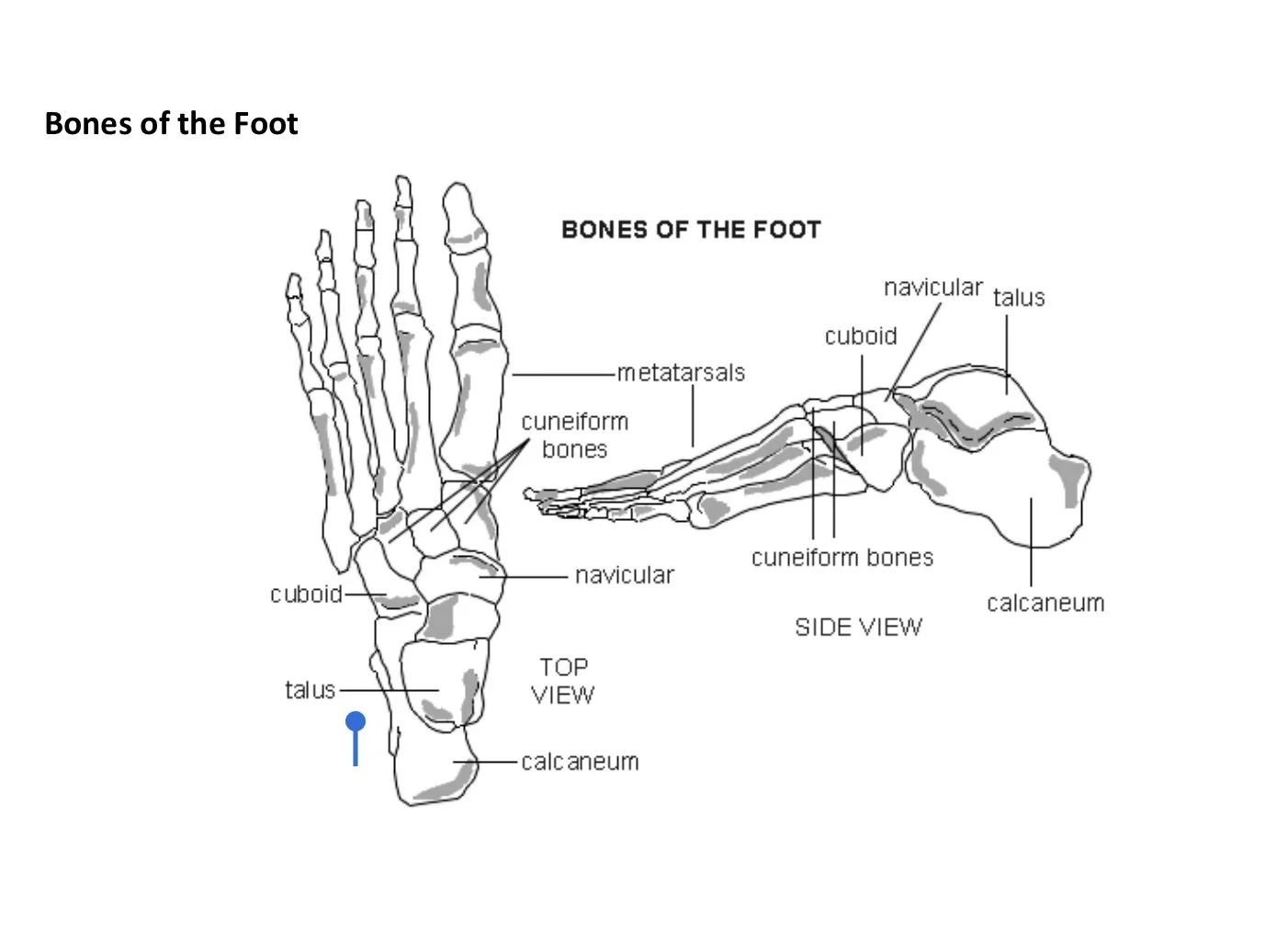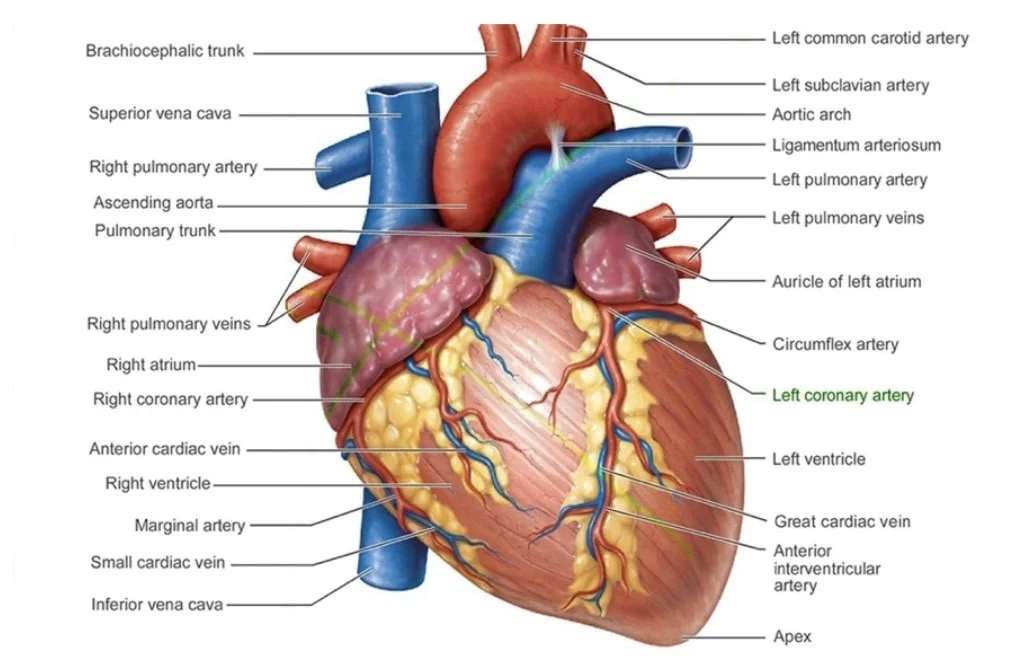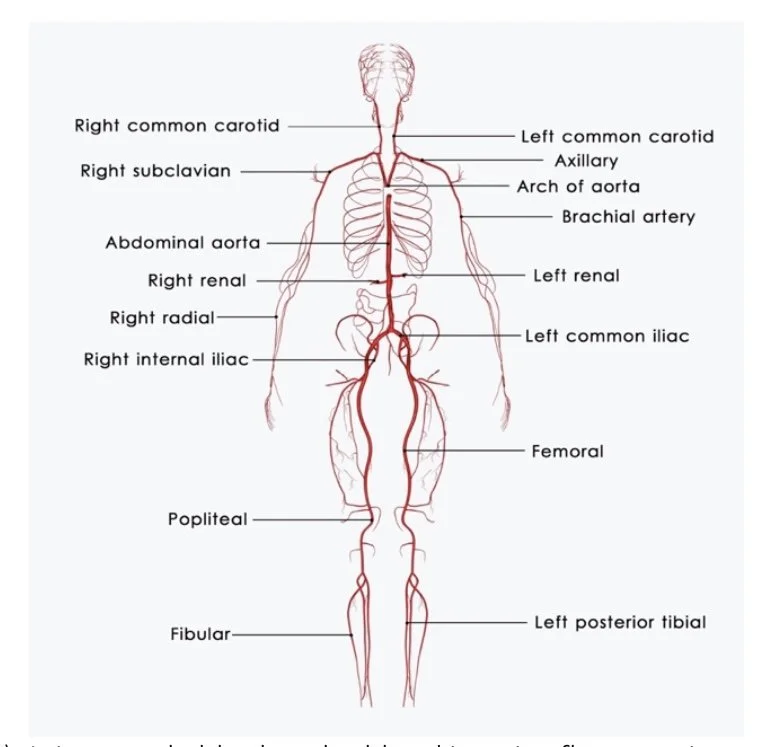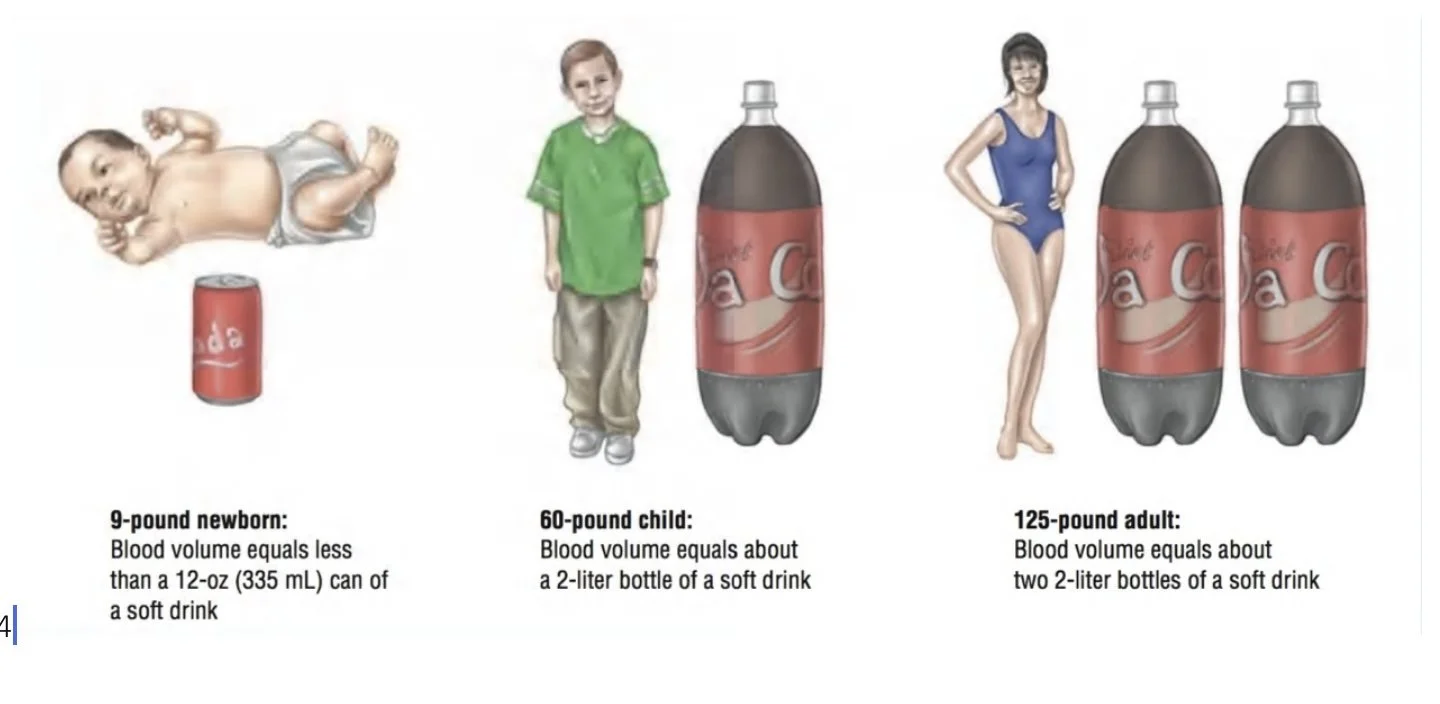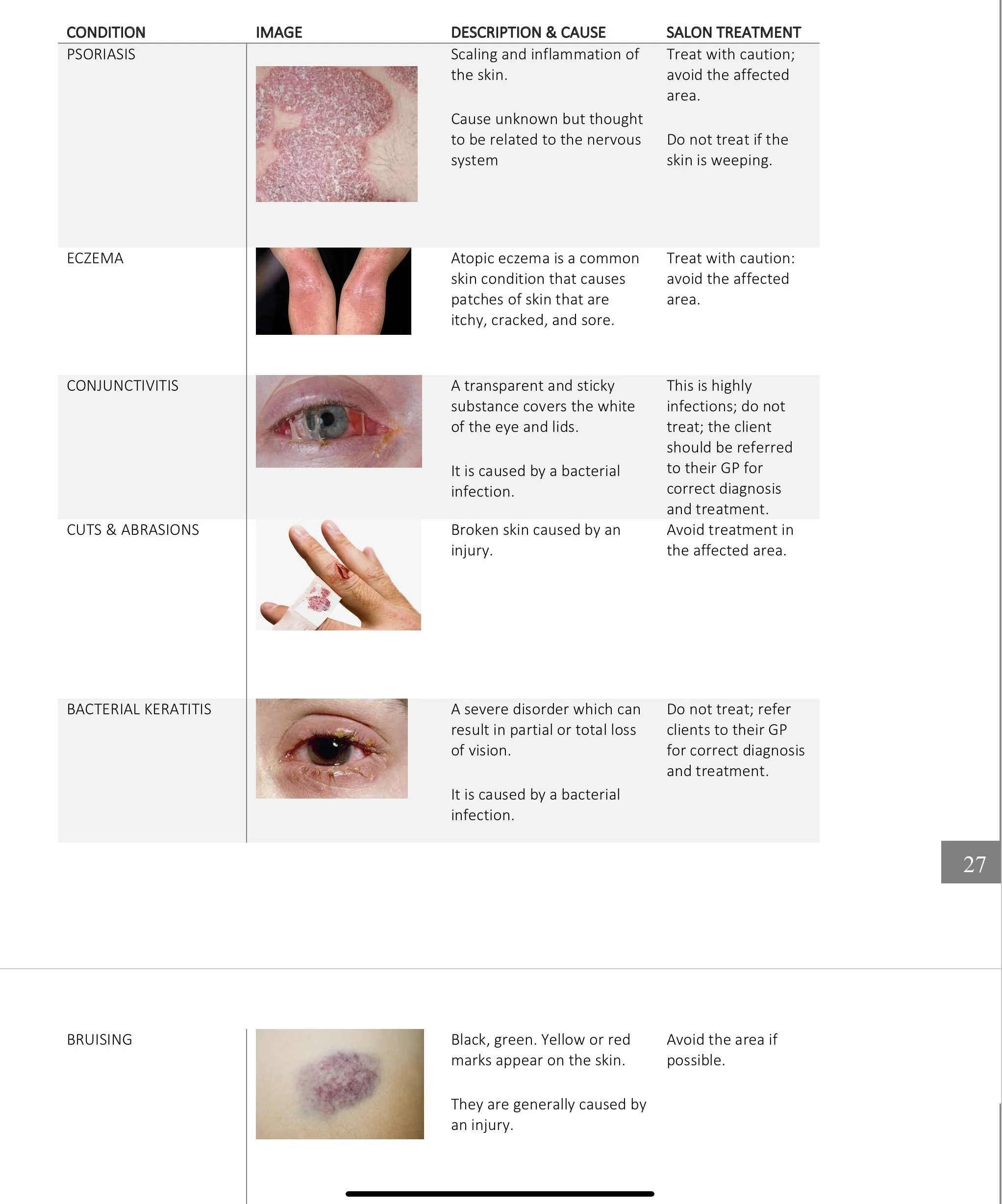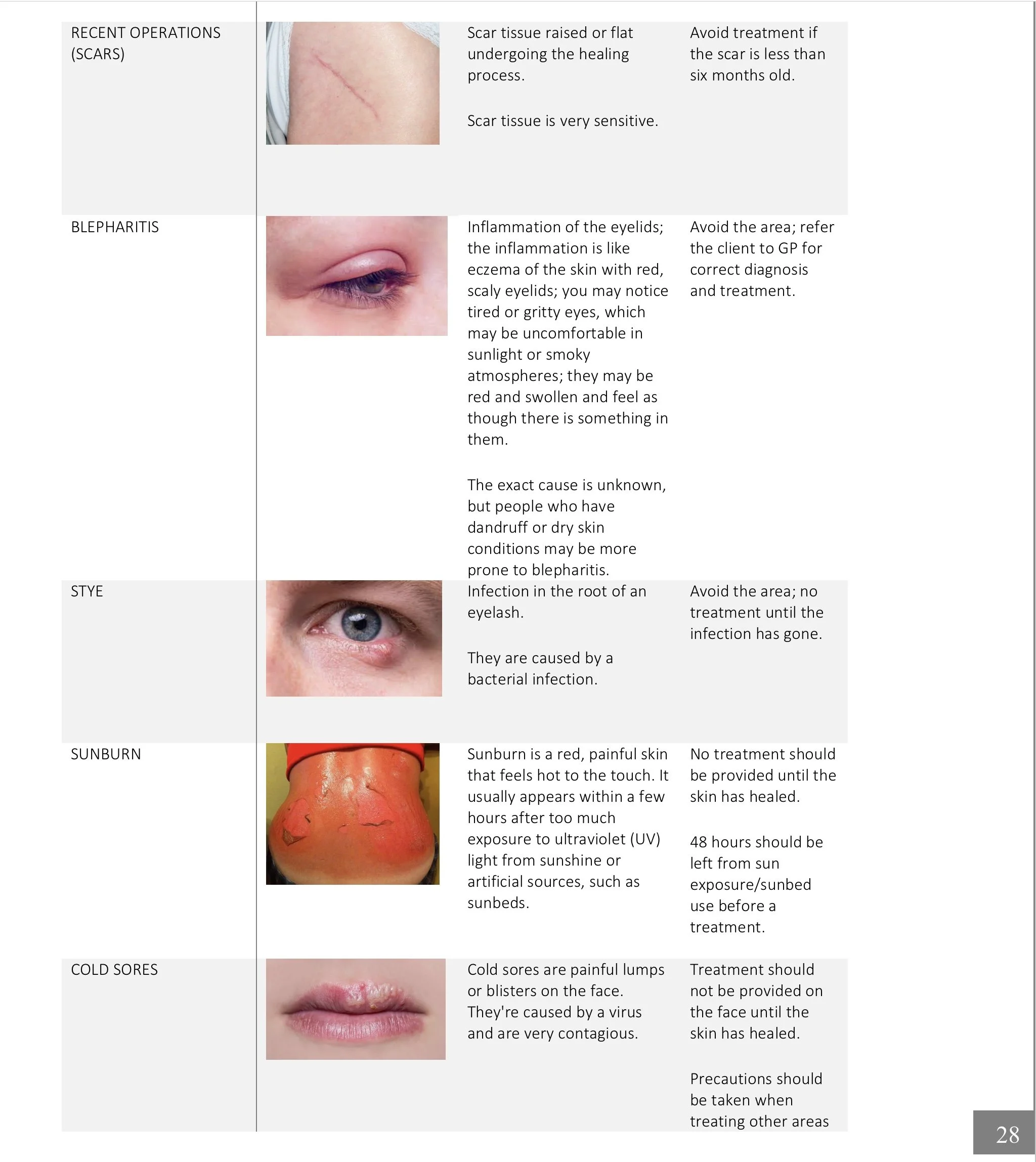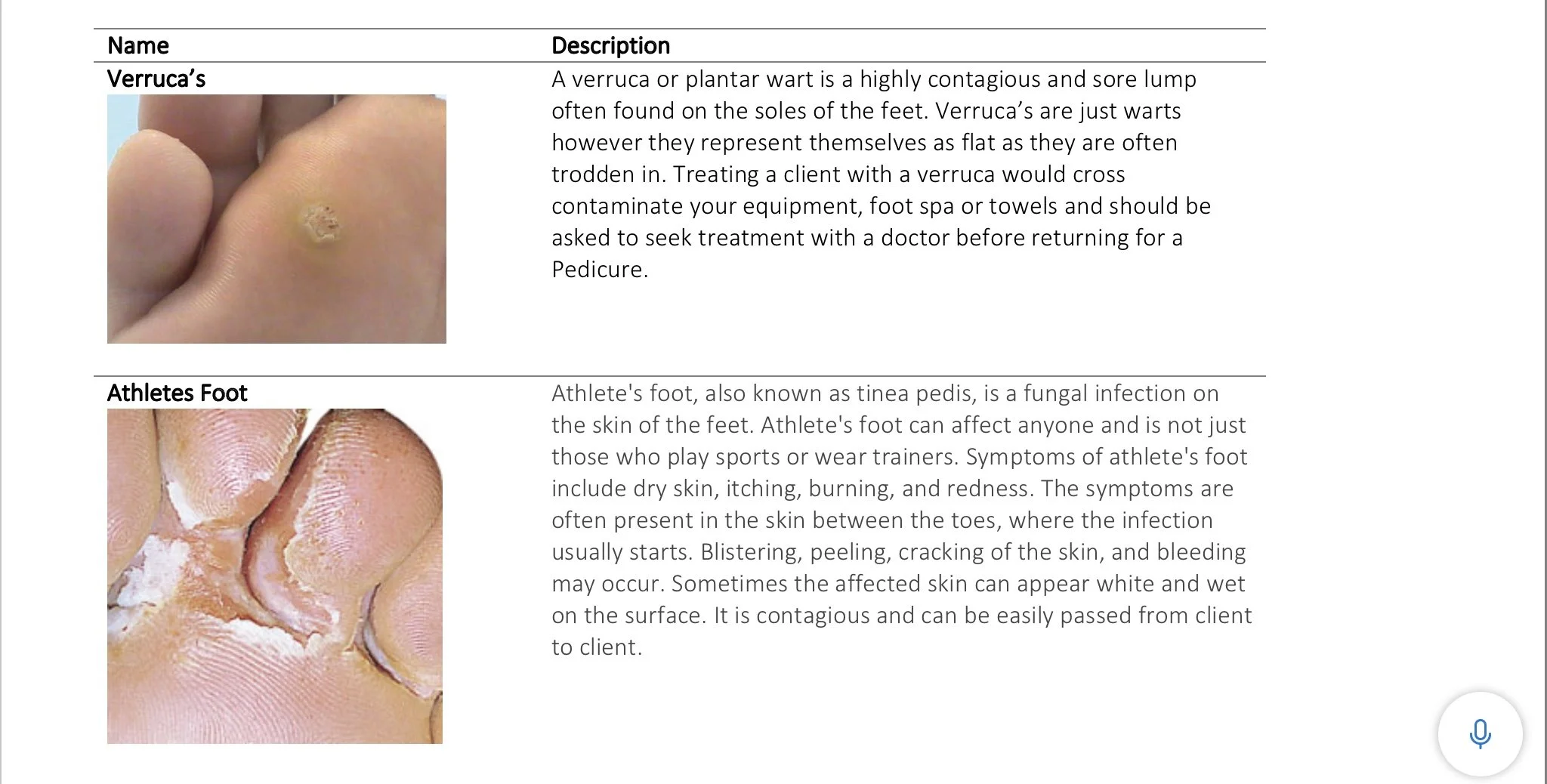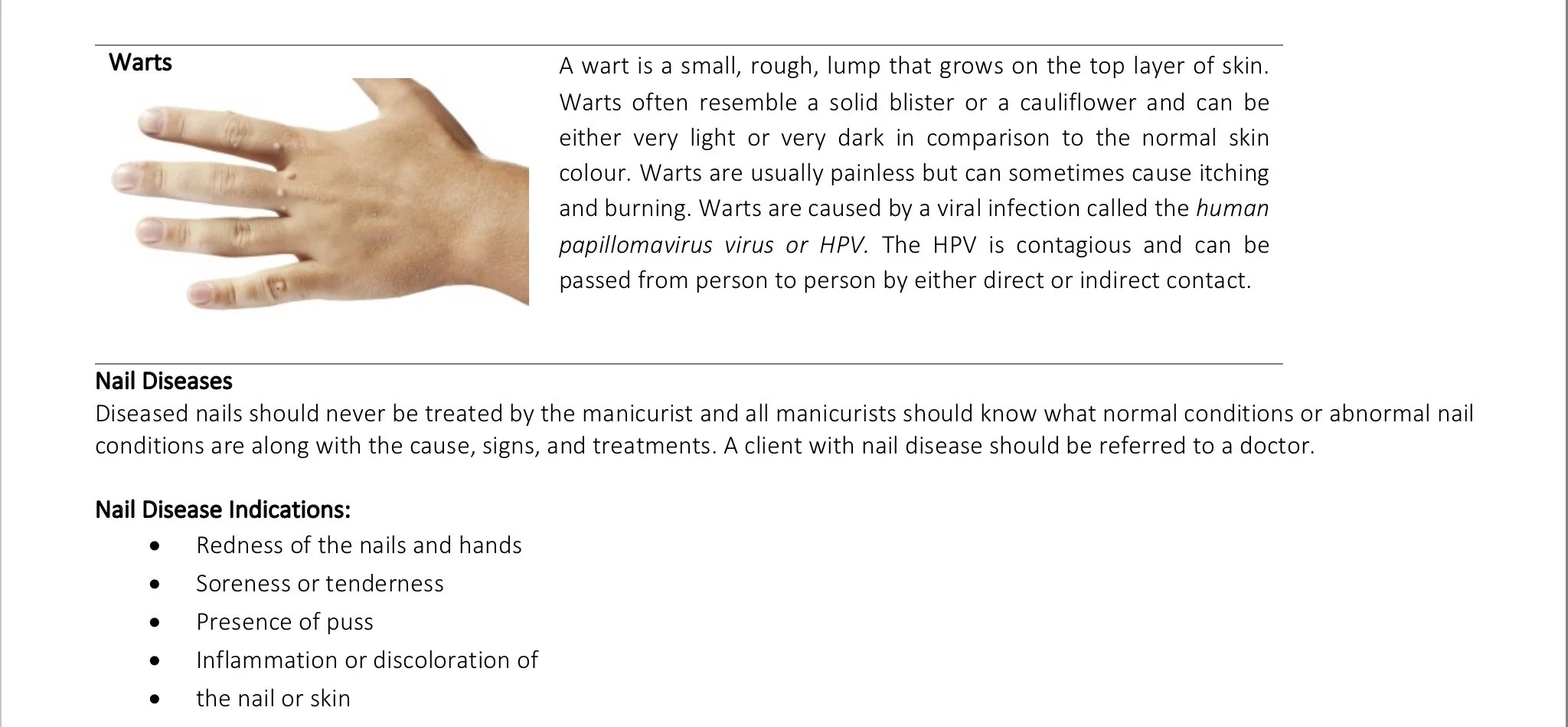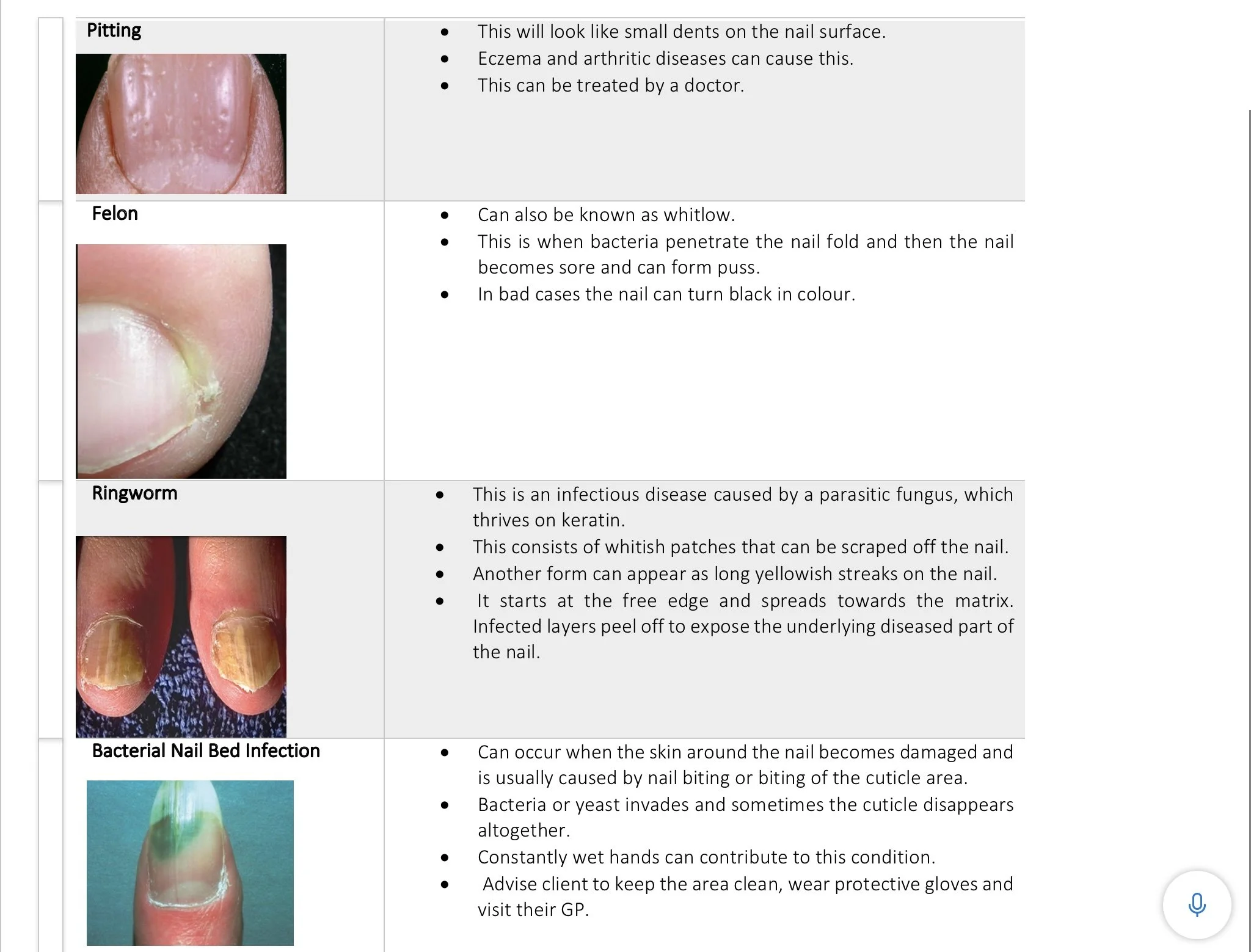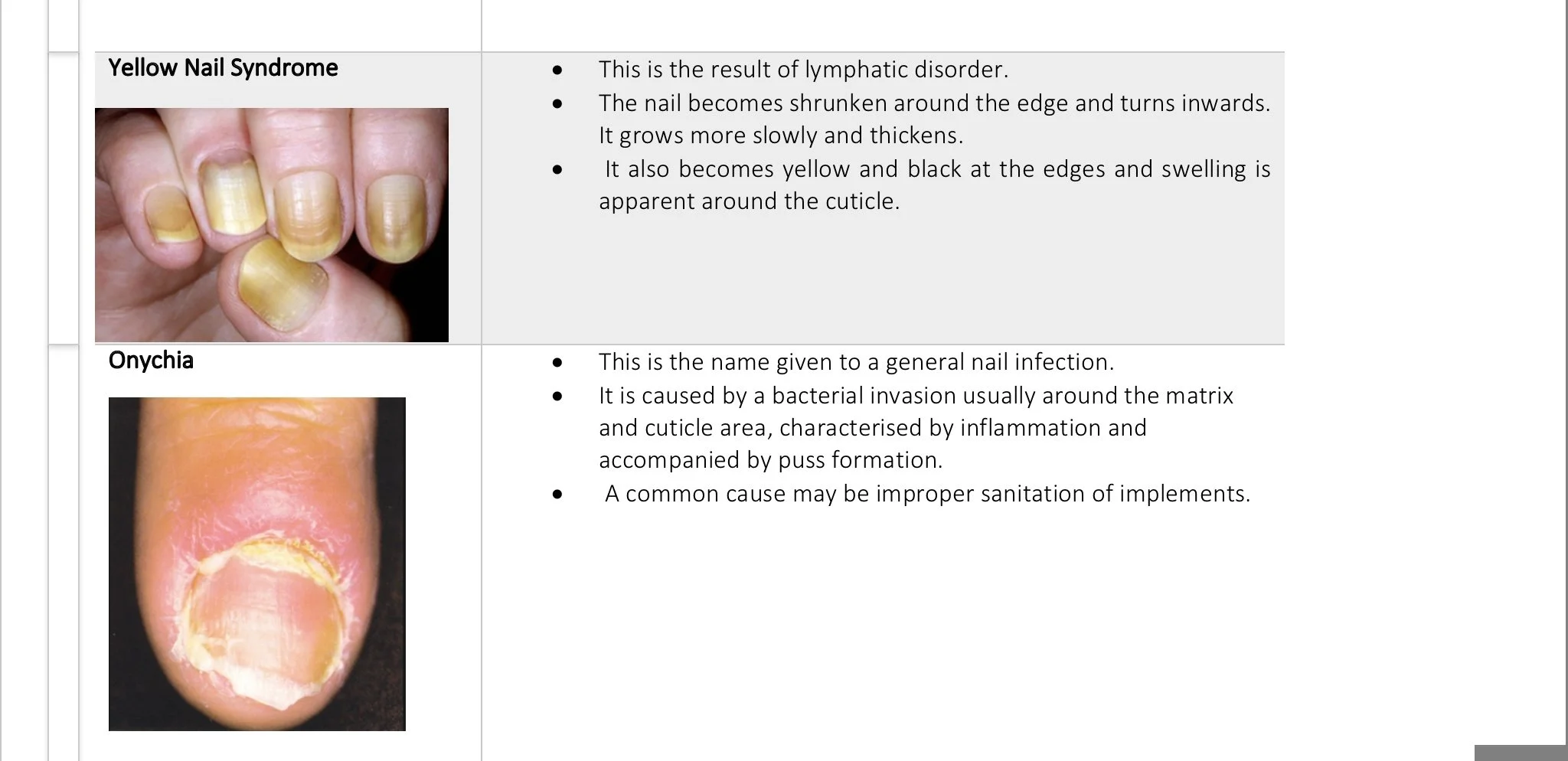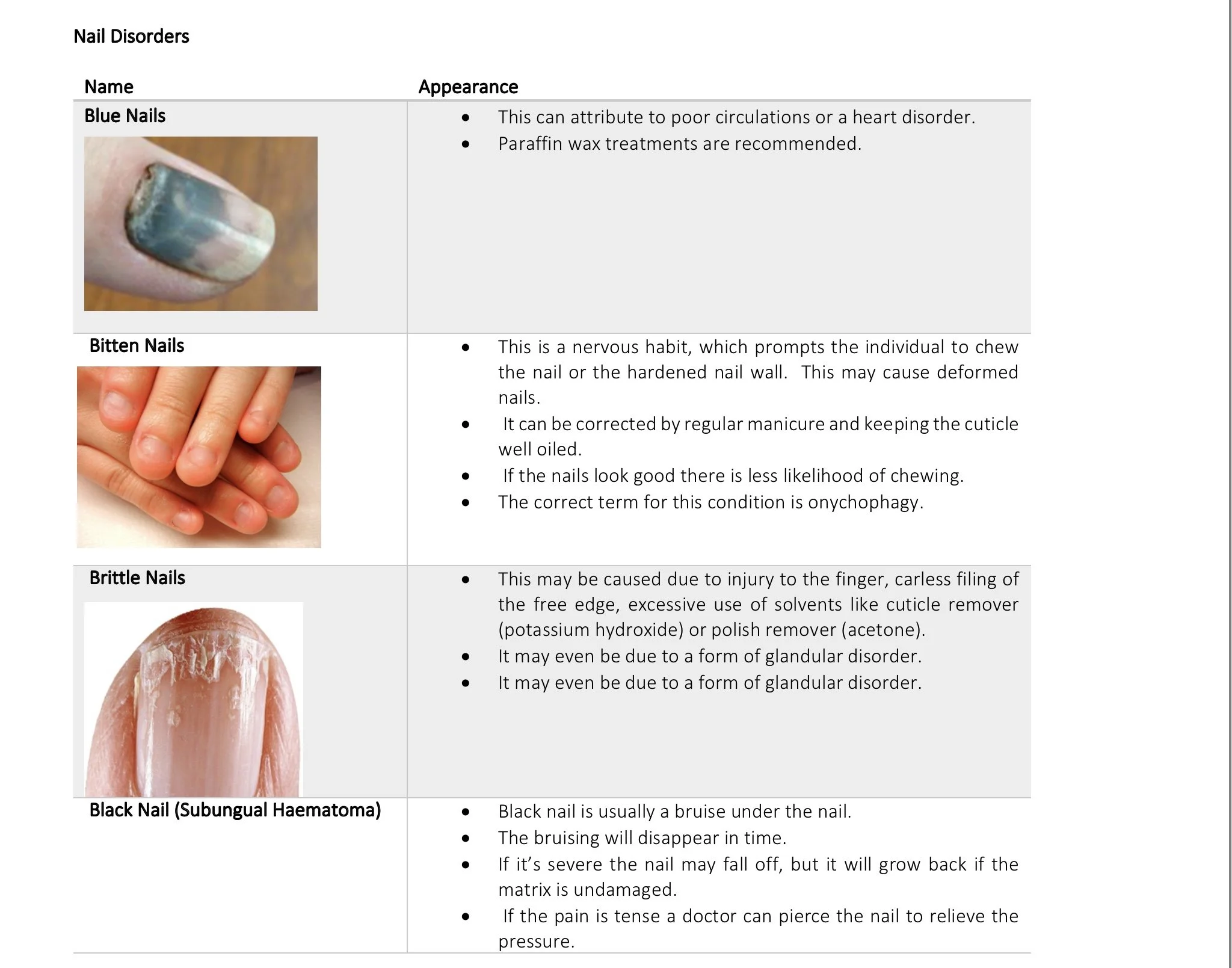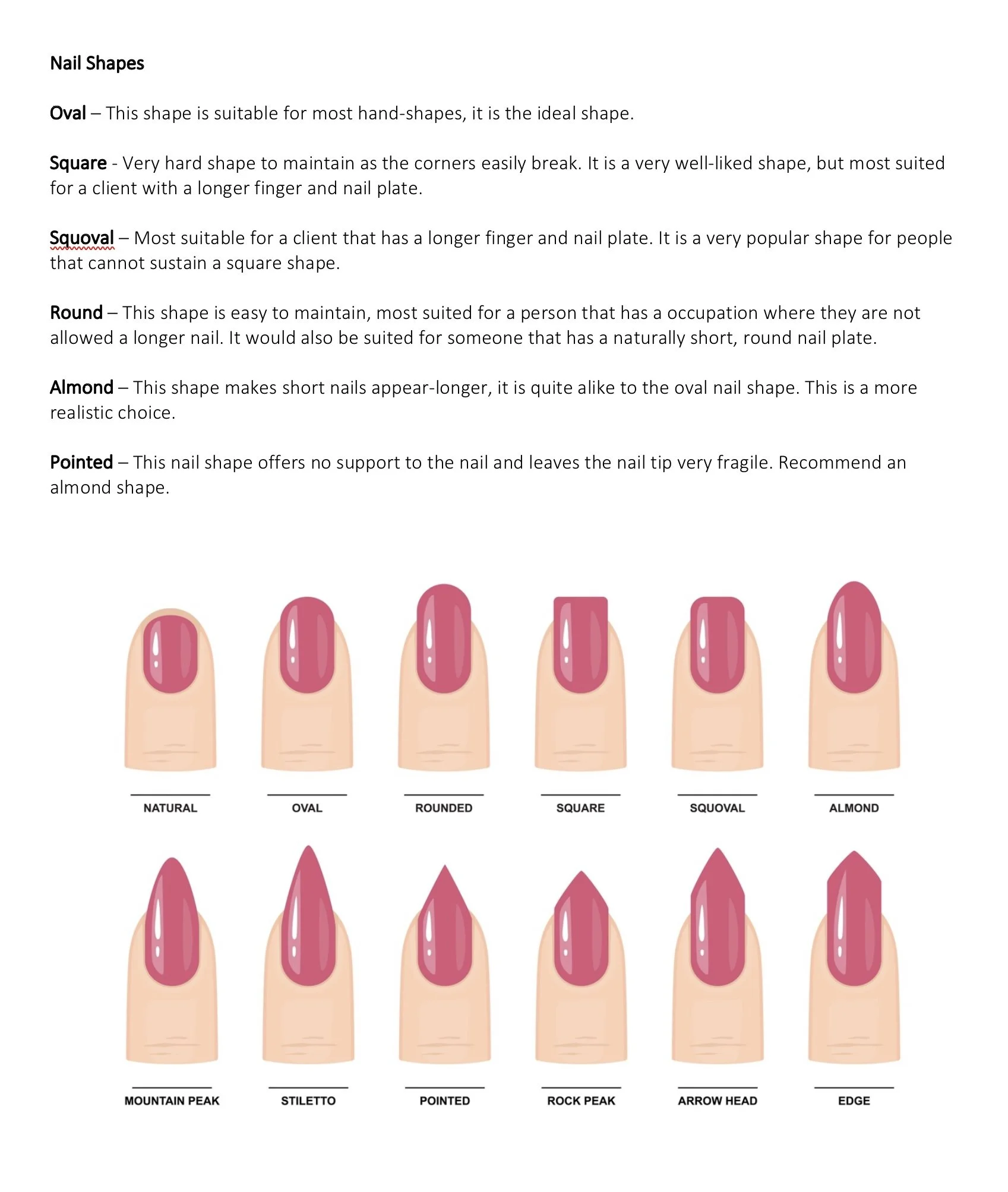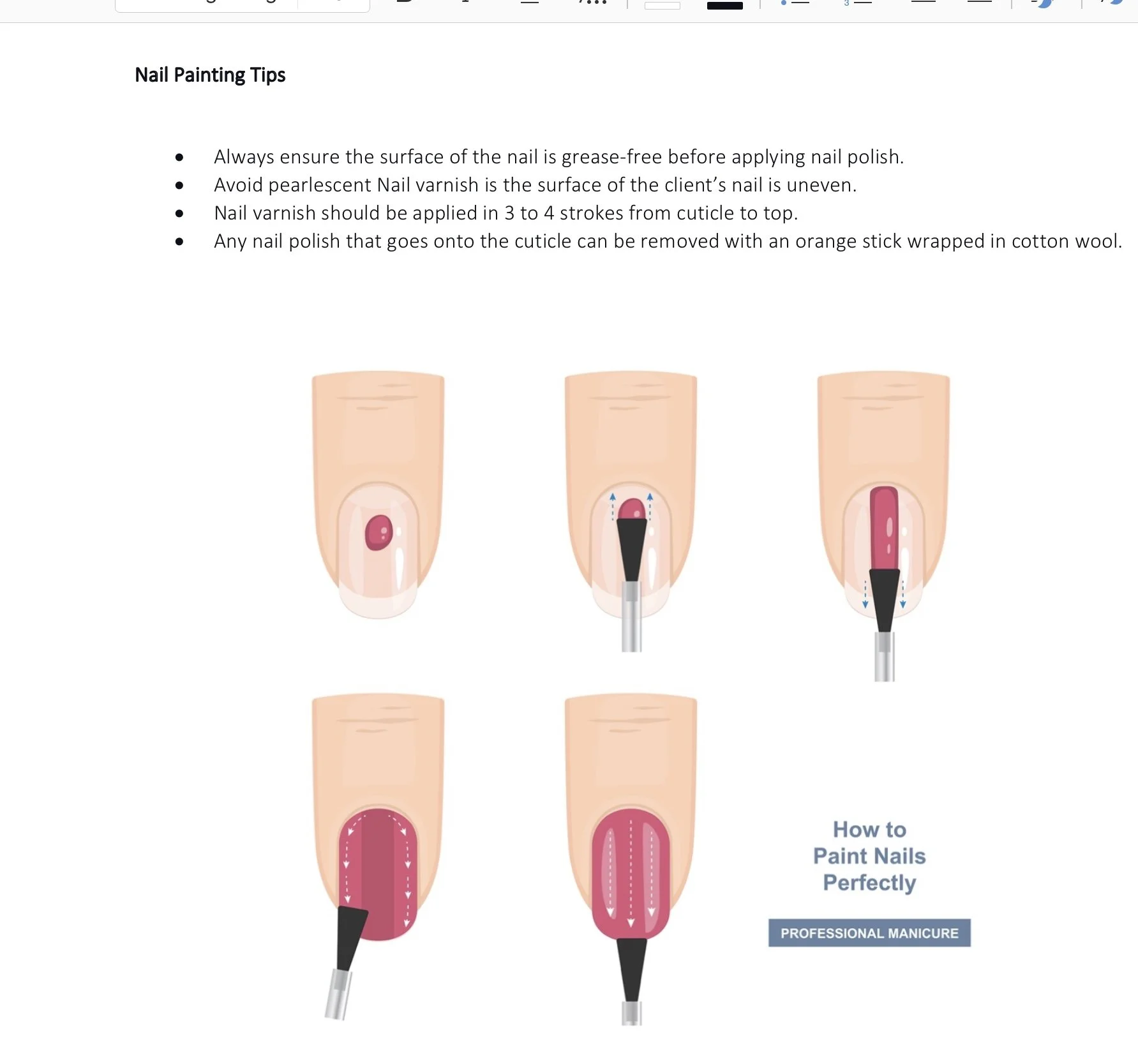MANICURE
Licensed for use by OH SO HASTY
All Rights Reserved
No part of this publication, document or any part thereof may be reproduced or transmitted in any form or by any means, electronic or mechanical, including photocopying, recording, storage in a retrieval system, or otherwise without the prior permission of the author.
Course Details
Aims
The course aims to ensure you; the student understands the basics of health and safety and anatomy and physiology of the treatment. This manual covers the treatment background, benefits, consultation and contra-indications, contra-actions, aftercare and equipment and products required to perform the treatment. The practical techniques will be covered on the practical session to ensure competency in the procedure.
Objectives
At the end of the course, you will be able to perform a treatment in a professional, safe and hygienic manner in a commercially acceptable time, along with experience in carrying out a thorough consultation with the knowledge of the background, benefits, consultation, contra-indications, contra-actions, aftercare, equipment and the products needed.
Accreditation
This course is accredited by:
· International approval limited
Insurance
Students will be able to gain insurance from the following provider(s) listed below, upon successful completion of your training:
Insurer name: INSYNC INSURANCE
A link will be sent on completion of the course
Medical Disclaimer
It is advised that you take medical advice if you or any of your clients have a health problem. Any qualification from OH SO HASTY BEAUTY ACADEMY will not qualify you to advise on or diagnose any medical condition.
Contact Details
Trainer: Della Jones
Address: 40 Hamble Drive, Penketh, Warrington, WA5 2HT
Phone Number: 07590264553
Email Address:
ohsohastybeauty@outlook.com
Website:
ohsohastybeauty.co.uk
Facebook Page:
@ohsohasty
Instagram:
@ohsohastynailsandbeautyacademy
The course will consist of theory and practical
Health & Safety
You will need to maintain a high standard of hygiene as well as health and safety, not only for yourself but also for your employees, clients and any visitors to your business.
It is a legal requirement for employees to display an approved health and safety poster or to provide employees with an equivalent leaflet or information.
All businesses are required by law to comply with the following acts, which are monitored and managed by The Health & Safety Executive (HSE). You should also get copies of the following regulations from your local council or off the HSE website.
Health and Safety at Work Act 1974
This protects your rights as an employer or employee. The law states that the employer must provide a safe working environment, provide health and safety training for staff, produce a written policy of the company’s health and safety policy and ensure that anyone on their premises is not exposed to any health or safety risks.
Trade Descriptions Act (1968 and 1972)
These Acts prohibit the use of false descriptions of goods or services. The information must always be accurate, false comparisons must not be made, and misleading price comparisons must not be made. A product may not be described as being of a 'reduced' price if it has not been available at a higher price for a minimum of 28 days.
General Data Protection Regulation GDPR
If you are collecting and storing personal data as a therapist, then you will need to comply with GDPR. You will need to decide which of the six lawful bases on which you will collect and store personal data and inform your clients of how and why you will retain their data and for how long. The Independent Commissioners Office will provide you with all relevant information.
Sale and Supply of Goods Act 1994
This states that goods must be as described and of satisfactory quality. They should be fit for purpose and safe for use. It is the responsibility of the retailer to correct a problem where the goods are not as described.
COSHH Regulations and Risk Assessment (Control of Substances Hazardous to Health)
COSHH regulations cover the essential requirements for controlling exposure to hazardous substances, and for protecting people who may be affected by them. You should carry out a COSHH assessment to identify all chemicals, products or other substances which could cause harm.
A substance is considered to be hazardous if it can cause harm to the body. It poses a risk if it is inhaled, ingested, in contact with the skin, absorbed through the skin, injected into the body or introduced to the body through cuts.
Always check the ingredients and instructions of all products to see what they contain and ensure they are correctly stored. If the product could cause harm, it should be listed on your COSHH assessment, together with what the risk is and who is at risk from it.
Next, decide on the degree of risk and who to minimise that risk. If you can, try to replace high-risk products with lower risk ones. Never leave chemicals identified as hazardous in areas accessible to the general public. Do not forget, COSHH substances include both those used for treatments and cleaning.
Local Government (Miscellaneous Provisions) Act 1982
A special treatment licence will be required if you carry out any form of massage, electrolysis or ear piercing and tattooing as they may produce blood and body tissue fluid. Each borough council in the UK has different requirements, so you should contact them to see whether they require you to hold a licence for the treatments you offer.
The Management of Health and Safety at Work Regulations 1999
Employers should make formal arrangements for maintaining and improving safe working conditions and practices. This includes competency training and risk assessments.
Management of Health and Safety at Work Regulations 1999
Employers should make formal arrangements for maintaining and improving safe working conditions and practices. This includes competency training and risk assessments.
The Manual Handling Operations Regulations 1992
This is relevant wherever manual lifting occurs to prevent skeletal and muscular disorders. The employer should undertake a risk assessment for all activities involving manual lifting.
The Personal Protective Equipment at Work Regulations 2002
This requires employers to identify activities which require special protective clothing, which must then be made available.
The Health and Safety (Display Screen Equipment) Regulations 1992
This covers the use of display screens and computer screens. This specifies the acceptable levels of radiation emissions from the screen, as well as identifying the correct posture and the number of rest periods.
The Electricity at Work Regulations 1992
Electrical items are potentially hazardous and should be used and maintained properly. You should always ensure that you are fully trained on a piece of equipment before operating it.
All electrical equipment should be regularly PAT tested to ensure it is safe to use. If any equipment is deemed to be faulty or unsafe, you should stop using it immediately and report the problem. Make sure the equipment is clearly marked as faulty until the problem has been corrected to avoid it being used by other members of staff.
Health and Safety (First Aid) Regulations 1981
Whatever the size of your business, you should always make sure you have a First Aid kit on-site, as well as an eyewash bottle. You should ensure this is fully stocked at all times. You should have at least one 'Appointed Person' on hand to take charge in an emergency who holds an HSE-approved basic first aid qualification. You can contact the HSE on 0845 345 0055 for a list of suitable training providers.
RIDDOR-The Reporting of Injuries, Diseases & Dangerous Occurrences Regulations 1995
Employers should report any such cases to the HSE Incident Contact Centre. This includes loss of sight, amputation, fracture and electric shock. In all cases where a personal injury of any type occurs, it should be recorded in an accident book.
The Regulatory Reform (Fire Safety) 2005
All premises must have adequate means of dealing with a fire, and all members of staff should know where these are. This can include fire extinguishers and blankets; however, you should only operate a fire extinguisher if you have been properly trained to do so. All equipment should be checked and maintained regularly.
Fire Drill notices should be clearly displayed and should inform people of what to do in case of a fire. All staff should be trained in the location of alarms, exits and meeting points.
Consumer Protection Act 1987
This Act aims to protect the customer from unsafe or defective services or products. All staff should be trained in using and maintaining products.
The Provision and Use of Work Equipment Regulations 1998
This states the duties of any users of the equipment. It identifies the requirements in selecting and maintaining suitable equipment, as well as the training and safe use of it.
Cosmetic Products (Safety) Regulations 2008
These regulations require that cosmetics and toiletries are safe for their intended purpose and comply with labelling requirements.
Disability Discrimination Act 1996
These Acts prohibit the use of false descriptions of goods or services. The information must always be accurate, false comparisons must not be made, and misleading price comparisons must not be made. A product may not be described as being of a 'reduced' price if it has not been available at a higher price for a minimum of 28 days.
The Equality Act 2010
gives disabled people important rights of access to everyday services. Service providers have an obligation to make reasonable adjustments to premises or to the way they provide a service. Sometimes it just takes minor changes to make a service accessible. What is considered a reasonable adjustment for a large business such as a bank, may be different from what is a reasonable adjustment for a small local salon. It is about what is practical in the service provider’s individual situation and what resources the business may have. They will not be required to make adjustments that are not reasonable because they are unaffordable or impractical.
Reporting Accidents
All accidents and near misses should be recorded in an Accident Report Book, which should be kept with a first aid kit on the premises.
The following information must be recorded:
Ø Full name and address of the person(s) involved in the accident.
Ø Circumstances of the accident.
Ø Date and time of the accident.
Ø All details of what may have contributed to the accident.
Ø The type of injury that occurred and treatment provided on or off-site.
Ø Details of any witnesses.
The Personal Protective Equipment at Work Regulations 1992
This act covers your requirements under the COSHH regulations. You are required to wear or provide to your employee's protective clothing or equipment (PPE) to ensure their health and safety when handling chemicals or coming into contact with bodily fluids.
What PPE will you need?
Powder-free non-latex Gloves that must be changed for each new client.
Disposable aprons.
Face Masks
Eyewear (optional)
Some therapists like to wear eye protection, although the risk is very low from spillages or splashes. However, a new apron, facemask and gloves should be worn before each new client.
Salon Hygiene, Health & Safety
Ø The salon should be cleaned thoroughly every day.
Ø The working area must be cleaned before and after every client.
Ø Fresh towels and linen should be used for every new client that has been laundered at a minimum of 60°C.
Ø Couch roll, disposable plastic sheeting or waterproof bed sheets need to be used to protect the couch and keep the area as clean as possible.
Ø Products should be dispensed from purpose-specific pump or spray bottles. Creams can be removed from jars or bottles with clean spatulas.
Ø Replace all lids on products securely after use.
Ø All tools that are non-disposable should be sterilised prior to use.
Ø Bins should be metal and have foot pedal operations and be emptied every day. Bins should be collected by an appropriate commercial waste disposal company.
Ø All fire exits should be clearly marked and accessible at all times.
Ø Read all labels and follow manufactures instructions.
Ø Know the hazardous warning signs on products.
Ø Store products safely and in accordance with safety data sheets.
Ø Ensure equipment is placed on a sturdy surface and cannot fall off.
Ø Check wires and plugs regularly on any electrical equipment. Ensure electrical equipment is PAT tested annually. Faulty equipment should not be used.
Ø A first aid kit that complies with the Health and Safety (First Aid) Regulations 1981.
Appearance of the Therapist
A therapist should ensure that they look well presented at all times. Therapists will be working in close contact with a client, and it is important that a professional image is observed.
A therapist should:
Ø Wear clean, freshly laundered and ironed uniform each day.
Ø Wear clean, flat, closed-toe shoes.
Ø Have short, clean, manicured nails.
Ø Have a fresh breath.
Ø Wear antiperspirant.
Ø Apply modest makeup for a natural look.
Ø Wear hair up and away from the face.
Ø Wear minimal jewellery.
Professional Ethics and Standards of Practice
Therapists should:
Ø Maintain the highest possible standards of professional conduct.
Ø Always be courteous and show respect for clients, colleagues and other professionals.
Ø Never gossip or criticise another therapist, salon or brand.
Ø Never talk across a client to another member of staff.
Ø Not to engage in conversations about politics, religion or race that may cause offence.
Ø Maintain a good reputation by setting an example of good conduct in all your communication with clients, team members and visitors to the business.
Ø Ensure to make the treatment or service special for every client.
Ø Respect client confidentiality.
Ø Explain the treatment to the client and answer any questions and queries prior to carrying out the treatment.
Ø Treat all clients in a professional manner at all times regardless of their race, colour, religion, sexual orientation or ability.
Ø Not to treat minors or clients with limited mental capacities, such as those with Alzheimer's or dementia without prior written consent from a parent or carer.
Practising good ethics is essential for the reputation of the therapist and the welfare of the clients. The following is an example of standards and ethics for therapists:
Ø Conduct yourself in a professional, honest and ethical manner.
Ø Promote professionalism
Ø Establish a treatment plan with your client and evaluate the outcome at the end of every session.
Ø Truthfully represent your credentials, qualifications and education, experience, training and competence relevant to practice.
Ø Maintain the confidentiality of the client.
Ø Take a full medical history of the client and ensure that they are suitable for treatment and the treatment is the best solution for their concerns.
Ø Give full aftercare advice.
Precautions Taken in the Salon to Prevent Contamination and Cross-Infection
Hands
Wash with soap/disinfectant and warm water before and after each client—dry hands with a paper towel or blower.
Surfaces
Wipe over with disinfectants, e.g. Alcohol, Surgical spirits.
Treatment of Wounds
If the skin bruises or bleeds after the insertion of a needle, a small pad of dry cotton wool should be used over the area to cover it and apply pressure until the bleeding stops. Apply aftercare solution to the area and work in a different area. The same applies to extractions or any other form of skin piercing. Use disinfectant to clean area.
Disposal
Sharp metal instruments, e.g. needles, lancets, should be placed in a sharps box after use. When the box is about 3/4 full, it may be disposed of by special arrangement. Usually collected by local health office and incinerated at a local hospital.
Metal Instruments
Sterilised before and after each client in Autoclave or in Glass bead steriliser, and wipe with Chlorhexidine Gluconate or Methylated spirits.
Skin Preparation
Do not use sharp or pointed instruments on or at least near areas of a client's skin that are obviously diseased, infected or inflamed. Except in facial treatments during the extracting phase (a tile with a lancet and cotton wool dampened with methylated spirits and an antiseptic solution containing Chlorhexidine Gluconate must be prepared, hands should be washed before and after extractions and finger cots or gloves must be used).
Cuts on your Hands
Cover existing wounds with a waterproof dressing, wash fresh cuts and encourage bleeding under running water and then cover with a waterproof dressing. Clean with an antiseptic. Always have a box of plasters/waterproof dressing available. No salon should be without a first aid kit.
Needles
Do not test needles on yourself. Test needles on a damp of cotton wool held with tweezers. Needles should only be used once, and needles must not be used on more than one client.
Creams
Tubes are better than jars. Always use a spatula to obtain creams from containers. Never use fingers and always close a container after use. Excess product must not be returned to containers.
Blood
Anything that has come into contact with blood must be disposed of in the correct manner. Pay attention to the following: Hands, lancets, tweezers, surface, disposal gloves, bin liners, cotton wool or gauze and needles)
Colds/Flu
Wear a surgical mask. Wash your hands regularly, especially after sneezing or blowing the nose. Also, wash hands in general after touching other surface areas. General advice - stay at home when feeling ill or send employees home if they develop cold/flu symptoms at work.
Waste Bins
Bin liners. Emptied regularly. Bins should have lids.
Gloves
Surgical gloves can be used, e.g. epilation or, to prevent contamination. Used always when performing any procedure that breaks the skin and any action that may come into touch with blood.
Instruments
Must be cleaned, sanitised and sterilised or where appropriate disposable tools should be used.
Sterilisation Methods
Autoclave
· Works like a pressure cooker.
· Consists of 2 chambers. Water in the lower chamber and instruments on the upper chamber.
· The principle of sterilisation is moist heat.
· The water boils in the lower chamber and steam is released towards the upper chamber. Instruments are left in the unit for 10 - 20 min. Afterwards, instruments must be placed in a sterile and clean container.
· The moist heat autoclave operates at 121°C and is considered a very effective means of sterilisation.
· Other types available, e.g., dry heat autoclave, vacuum autoclave, flash instrument autoclave.
· The time and temperature of dry heat autoclave is 160°C (320°F) for 2 hours or 180°C (356°F) for one hour.
· Consult manufacturer's instructions and local government laws and regulations on sterilisation times and temperatures.
Advantages of an Autoclave
· Economical and very effective
· Non-toxic on instruments
· Easy to operate
Disadvantages of an Autoclave
· Sharp instruments can become blunt.
· Metal instruments might rust. Recommend use of stainless-steel instruments.
· Expensive
· Plastic instruments will be damaged.
· Autoclaves will need to be kept clean.
· Regular servicing and calibration are required of the device.
Glass Bead Steriliser
§ Operates at approximately 300°C.
§ Metal instruments will thus be completely sterilised within minutes.
§ Only the parts covered with beads will be sterilised.
§ The unit takes + 20 - 30 minutes to warm up before sterilisation can take place.
§ If more than one instrument is placed in the container, a longer time must be added for sterilisation.
§ Consult manufacturers` instructions and local government laws and regulations on sterilisation times and temperatures
Wet Sterilisation (Chemical)
Asepsis can be obtained by washing down all surfaces, walls, floors, treatment beds, tiles, trolleys, work surfaces, basins etc. after basic cleaning with an antiseptic solution. EG: Antiseptic solution concentrates, diluted according to manufacturers' instructions. Towels can also be disinfected in this method. If metal tools are sterilised by this method, the liquid must contain a rust inhibitor.
UV Cabinet
· They are used for the maintenance of your sterilisation process.
· Basically, used as a storage unit.
· They are not used for sterilisation only for sanitation.
· This cabinet will keep your item as clean as it was when you first inserted it.
Antiseptics and Disinfectants
Antiseptic
A diluted disinfectant that is safe to apply to the skin. Its' task is to slow down multiplication, growth and in some cases may destroy/kill micro-organisms if the strength of the solution is correct, e.g. some soaps (hands), alcohol and hydrogen peroxide etc.
Disinfectant
A chemical agent which destroys or kills all micro-organisms. Safe to apply on surfaces but too toxic to be applied directly onto the skin, e.g. Quaternary Ammonium compound/Quats, formalin, ethyl or grain alcohol.
Ergonomics
Posture is important, whether you are sitting or standing up to do a treatment. Try to find a working position that is comfortable for you and reduces the need to lean over to just one side.
Using height adjustable treatment couches and chairs. Choose a height that reduces your need for bending over the client. Ideally, your back should be at a 90-degree angle. Your chair should be comfortable to avoid pressure point sores or injury.
Try to avoid twisting the neck, keep your head upright and keep your shoulders relaxed.
Never ignore pain; look at ways to alleviate the symptoms. If you cannot take a break during treatment, then you can adopt gentle stretching techniques.
Repetitive strain injuries can be caused by using the same movements over and over again. Try to avoid repetitive flexing of the wrist and instead alternate by bending elbows or shoulders instead. Equipment should feel comfortable in your hand and have as minimal vibration as possible.
Storage
Ø Make sure you receive a copy of Material Safety Data Sheets (MSDS) from your suppliers.
Ø All staff must be trained on the use of products and equipment.
Ø Training manuals and information leaflets should be accessible to all staff.
Ø Store your products correctly by following the guidance on the MSDS.
Ø Carry out a risk assessment on each product or COSHH report if required.
Ø Keep products in original containers where possible and ensure any decanted products are fully labelled in smaller, purpose-built containers.
Ø Keep all flammable products out of direct sunlight and at room temperature or below.
Mobile therapists must make suitable travel arrangements to avoid spillage and ensure safe working practice and be professional in appearance.
Insurance
There are several types of insurance that are potentially relevant to you as a therapist. The most important is the 'Professional Indemnity Insurance' and 'Public Liability Insurance'. Both of these are necessary in the unlikely event that a client decided to sue you.
Public Liability Insurance - This covers you if a member of the public, i.e. a client or passer-by is injured on your premises or if their personal property is damaged in any way.
Professional Indemnity Insurance - This protects you should a client decide to sue you claiming personal injury or damage as a result of treatments carried out by you.
Employer’s Liability Insurance - This is only necessary if you hire others to work for you. This type of insurance would cover you should a member of your staff have an injury on your premises.
Product Liability Insurance - This insurance is important if you plan to use, manufacture or sell products as part of your business. This will protect you in the event that a client is dissatisfied with the product or experiences a reaction to using the product.
Car Insurance - If a car is used for business purposes, ensure that this is covered by the policy and that theft of equipment is included.
Anatomy and Physiology
Skin Anatomy
The skin makes up around 12% of an adult's body weight. The skin has several important functions which include:
S
Sensation
The main sensory organ for temperature control, pressure, touch and pain.
H
Heat Regulation
The skin helps to regulate the bodies temperature by sweating to cool the body down when it overheats and shivering when the body is cold.
A
Absorption
Some creams, essential oils and even much-needed water can be absorbed through the skin.
P
Protection
Overexposure to UV light may harm the skin; the skin protects itself by producing a pigment, called melanin, which we see when we tan. Bacteria and germs are also prevented from entering the skin by a protective barrier called the Acid Mantle. This barrier also helps to protect against moisture loss.
E
Excretion
Waste products and toxins are eliminated from the body through sweat glands.
S
Secretion
Sebum and sweat are secreted onto the skin's surface. The sebum keeps the skin lubricated and soft, and the sweat combines with the sebum to form the acid mantle.
V
Vitamin D Production
Absorption of UV rays from the sun helps with the formation of Vitamin D, which is needed by the body for the formation of strong bones and good eyesight.
Skin is made up of 3 major layers known as the Epidermis, Dermis and the Subcutaneous.
The Epidermis
This is the outermost layer of the skin. There are various layers of cells within the epidermis, the outermost of which is called the stratum corneum (or horny layer). The layers can be seen clearly in the diagram of the skin. The surface layer is composed of twenty-five to thirty sub-layers of flattened scale-like cells, that are continually being exfoliated off by friction and replaced by the cells beneath.
The surface layer is considered the real protective layer of the skin. Cells are called keratinised cells because the living matter within the cell (protoplasm) has changed to form a protein (keratin) which helps to give the skin its protective properties.
New skin cells are formed in the deepest layer of the epidermis. This layer is known as the stratum basale. New cells being to gradually move from this layer towards the stratum corneum to be shed. As they move towards the surface, the cells undergo a process of change from a round, living cell to a flat, hardened cell.
The layers of the epidermis from top to bottom are known as:
· Stratum Corneum/Horny Layer
· Stratum Lucidum/Clear Layer (only found in the palms on the hands and soles of the feet)
· Stratum Granulosum/Granular Layer
· Stratum Spinosum/Prickle Cell Layer
· Stratum Basale/Basal or Germinative Layer
Dermis Layer
The dermis is a tough and elastic layer containing white fibrous tissue interlaced with yellow elastic fibres.
The dermis is an expanse layer and contains:
· Blood vessels
· Lymphatic capillaries and vessels
· Sweat glands and their ducts
· Sebaceous glands
· Sensory nerve endings
· The erector pili – which involuntary activates tiny muscles attached to the hair follicle in cold weather to trap heat.
· Hair follicles, hair bulbs and hair roots
Subcutaneous Layer
This is the deepest layer of the skin and located beneath the dermis. It connects the dermis to the underlying organs. The subcutaneous layer is mainly composed of loose fibrous connective tissue and fat (adipose) cells interlaced with blood vessels. This layer is generally around 8% thicker in females than in males. The functions of this layer include insulation, storage of lipids, cushioning of the body and temperature regulation.
Muscles
Muscles are classified into three different types, which are skeletal, smooth and cardiac.
Skeletal muscles, also known as striated due to its appearance or voluntary due to its action, are attached to bones and deal with movement. These muscles are made up of fine, thread-like fibres of muscles containing light
and dark bands. Skeletal muscles can be made to contract and relax by voluntary will. They have striations due to the actin and myosin fibres and create movement when contracted.
This system gives individuals the ability to move using muscles and the skeleton. It consists of the body's bones, muscles, tendons, ligaments, joints, cartilage, and other connective tissue.
Smooth muscles, also called unstriated or involuntary, tend to be found within hollow organs such as blood vessels, the intestines and the respiratory tract. This muscle works automatically with no participant control. This type of muscle does not tire easily, and the contractions are slow, rhythmic and automatic.
Cardiac muscle is what the heart is made up of and only exists in your heart. It is similar in appearance to skeletal muscle in that it is striated. This type of muscle never tires and contracts and relaxes with no participant control. It is made up of short, cylindrical fibres and is purely controlled by the nervous system.
There are over 650 different types of muscles in the human body, making up nearly half of the body weight. The main function is to move joints, to which they are joined, by shortening and pulling one end of the muscle closer to the other end. Each muscle is made up of muscle fibres that are controlled by the brain, sending an impulse to the fibres via the nerves.
When a muscle is damaged, fibres become torn, and the connective tissue around the muscle is also damaged. The fibres are damaged, and fluid seeps out of torn fibres, which causes localised swelling. This fluid tends to stick the fibres together, which causes pain as the muscle is irritated by the slightest contraction. Stretching exercises will increase the length, flexibility and tone of muscles which allows the joint to move further than before.
Bones of the body
The Skeletal System serves many important functions; it provides the shape and form for our bodies in addition to supporting, protecting, allowing bodily movement, producing blood for the body, and storing minerals.
Functions :
Its 206 bones form a rigid framework to which the softer tissues and organs of the body are attached.
Vital organs are protected by the skeletal system. The brain is protected by the surrounding skull, and the heart and lungs are encased by the sternum and rib cage.
Bodily movement is carried out by the interaction of the muscular and skeletal systems. For this reason, they are often grouped together as the muscular-skeletal system. Muscles are connected to bones by tendons. Bones are connected to each other by ligaments. A joint is where bones meet one another. Muscles that cause movement of a joint are connected to two different bones and contract to pull them together. An example would be the contraction of the biceps and the relaxation of the triceps. This produces a bend at the elbow. The contraction of the triceps and relaxation of the biceps produces the effect of straightening the arm.
Blood cells are produced by the marrow located in some bones. An average of 2.6 million red blood cells is produced each second by the bone marrow to replace those worn out and destroyed by the liver.
Bones serve as a storage area for minerals such as calcium and phosphorus. When an excess is present in the blood, the build-up will occur within the bones. When the supply of these minerals within the blood is low, it will be withdrawn from the bones to replenish the supply.
Divisions of the Skeleton:
The human skeleton is divided into two distinct parts:
The axial skeleton consists of bones that form the axis of the body and support and protect the organs of the head, neck, and trunk:
Skull
Sternum
Ribs
Vertebral Column.
The appendicular skeleton is composed of bones that anchor the appendages to the axial skeleton:
Upper Extremities
Lower Extremities
Shoulder Girdle
Pelvic Girdle.
(The sacrum and coccyx are considered part of the vertebral column)
Types of Bone
The bones of the body fall into four general categories: long bones, short bones, flat bones, and irregular bones.
Long bones are longer than they are wide and work like levers. The bones of the upper and lower extremities (e.g. humerus, tibia, femur, ulna, metacarpals, etc.) are of this type.
Short bones are short, cube-shaped, and found in the wrists and ankles. Flat bones have broad surfaces for the protection of organs and attachment of muscles (e.g. ribs, cranial bones, bones of shoulder girdle).
Irregular bones are all others that do not fall into the previous categories. They have varied shapes, sizes, and surface features and include the bones of the vertebrae and a few in the skull.
Bone Composition:
Bones are composed of tissue that may take one of two forms—compact or dense bone, spongy or cancellous bone. Most bones contain both types.
Compact bone is dense, hard and forms the protective exterior portion of all bones.
Spongy bone is inside the compact bone and is very porous (full of tiny holes). Spongy bone occurs in most bones.
The charts on the following pages show the main bones that you will need to have good knowledge of.
The Muscles of the Hand and Arm
All body systems are linked by the cardiovascular system, a transport network that affects every part of the body. To maintain homeostasis, the cardiovascular system must provide for the rapid transport of water, nutrients, electrolytes, hormones, enzymes, antibodies, cells, and gases to all cells. In addition, it contributes to body defences and the coagulation process and controls body temperature. The term cardiovascular refers to the cardiac (heart) muscle, the vascular system (a network of blood vessels that includes veins, arteries, and capillaries), and the circulating blood. Thus, the three primary components of the cardiovascular system are:
Heart
Circulating blood
Blood vessels (the circulatory system)
Organ/Structure
Primary Functions
Heart
· Muscular organ about the size of an adult's closed first
· Contractions push blood throughout the body
· The average heart beats 60 to 80 times per minute
Arteries
· Transport blood from the right and left chambers of the heart to the entire body
· Large arteries branch into arterioles the farther they are from the heart
· Carry oxygenated blood that is bright red in colour
· Have thicker elastic walls than veins do
· Have a pulse
· Are located deep in muscles/tissues
Veins
· Blood is transported from peripheral tissues back to the heart and lungs
· Large veins branch into venules in the peripheral tissues
· Deoxygenated blood is carried back to the lungs to release carbon dioxide
· Carry blood that is normally dark red in colour
· Have thinner walls than arteries; walls appear bluish
· Valves prevent the backflow of blood
· Are located both deep and superficially (close to the surface of the skin)
Capillaries
· Connect arterioles with venules via microscopic vessels
· Oxygen and carbon dioxide, nutrients, and fluids in tissue capillaries are exchanged
· Waste products from tissue cells are passed into capillary blood, then onto removal from the body
· Carry blood that is a mixture of arterial blood and venous blood
Circulating Blood
· Oxygen and carbon dioxide, nutrients, and fluids are transported by circulating blood
· Waste products are removed
· Nutrients are disbursed
· Regulates body temperature and electrolytes
· Regulates the blood-clotting system
The Heart
The human heart is a muscular organ about the size of a man's closed fist. The heart contains four chambers and is located slightly left of the midline in the thoracic cavity. The two atria are separated by the interatrial septum (wall), and the interventricular septum divides the two ventricles. Heart valves are positioned between each atrium and ventricle so that blood can flow in one direction only, thereby preventing backflow. The right atrium of the heart receives o2-poor blood from two large veins: the superior vena cava and the inferior vena cava. The superior vena cava brings blood from the head, neck, arms, and chest; the inferior vena cava carries blood from the rest of the trunk and the legs. Once the blood enters the right atrium, it passes through the heart valve (right atrioventricular, or tricuspid, valve) into the right ventricle. When blood exits the right ventricle, it begins the pulmonary circuit—it enters the right and left pulmonary arteries. Arteries of the pulmonary circuit differ from those of the systemic circuit because they carry deoxygenated blood.
Like veins, they are usually shown in blue on colour-coded charts. These vessels branch into smaller arterioles and capillaries within the lungs, where gaseous exchange occurs (o2 is picked up, and Co2 is released). From the respiratory capillaries, blood flows into the left and right pulmonary veins and then into the left atrium. The left atrium also has a valve (left atrioventricular, bicuspid, or mitral valve). Blood flows through the mitral valve into the left ventricle. When blood exits the left ventricle, it passes through the aortic semilunar valve and into the systemic circuit by means of the ascending aorta. The systemic circuit carries blood to the tissues of the body. If a valve malfunctions, blood flows backwards and a heart murmur results. The right side of the heart pumps o2 poor blood to the lungs to pick up more o2; the left side pumps o2-rich blood toward the legs, head, and organs. The heart's function is to pump sufficient amounts of blood to all cells of the body by contraction (systole) and relaxation (diastole). Because the lungs are close to the heart, and the pulmonary arteries and veins are short and wide, the right ventricle does not need to pump very hard to propel blood through the pulmonary circuit. Thus, the heart wall of the right ventricle is relatively thin. On the other hand, the left ventricle must push blood around the systemic circuit, which covers the entire body. As a result, the left ventricle has a thick, muscular wall and a powerful contraction.
Blood pressure increases during ventricular systole and decreases during ventricular diastole. Blood pressure not only forces blood through vessels but also pushes it against the walls of the vessels like air in a balloon. Therefore, it can be measured by how forcefully it presses against vascular walls.
The average heart beats 60 to 80 times per minute. Children have faster heart rates than adults, and athletes have slower rates because more blood can be pumped with each beat. During exercise, the heart beats faster to supply muscles with more blood. During and after meals, it also beats faster to pump blood to the digestive system. During a fever, the heart pumps more blood to the skin surface to release heat. Remember that all
responses are designed to maintain homeostasis. The heart rate (pulse rate) is measured by feeling for a pulse and counting the pulses per minute.
The Vessels and Circulation
Three kinds of blood vessels exist in the human body:
Arteries
Veins
Capillaries
This intricate system travels to every inch of the human body through repeatedly branching vessels that get smaller and smaller as they move away from the heart (arteries) and then get larger again as they return toward the heart (veins). The largest artery (aorta) and veins (venae cavae) are approximately 1 inch wide.
Arteries
Arteries are highly oxygenated vessels that carry blood away from the heart (efferent vessels). They branch into smaller vessels, called arterioles, and into capillaries. Arteries appear brighter red in colour, have thicker elastic walls than veins do, and have a pulse.
Veins
Blood is carried toward the heart by the veins (afferent vessels). It is remarkable that the blood in veins flows against gravity in many areas of the body; these vessels have one-way valves and rely on weak muscular action to move blood cells. The one-way valves prevent the backflow of blood. All veins (except the pulmonary veins) contain deoxygenated blood. Veins appear bluish in colour under the skin and have thinner walls than arteries. You should become familiar with the principal veins of the arms and legs. The antecubital area of the forearm is most commonly and generally the largest and best-anchored vein. Others in the antecubital area that are acceptable are the basilic vein and the cephalic vein.
Capillaries
Capillaries are tiny microscopic vessels that connect or link arteries (arterioles) and veins (venules) and may be so small in diameter as to allow only one blood cell to pass through at any given time. They are the only vessels that permit the exchange of gases (o2 and Co2) and other molecules between blood and surrounding tissues.
Capillaries do not work independently but are a part of an interconnected network. Each arteriole ends in dozens of capillaries (capillary bed) that eventually feed-back into a venule (when gas/ the nutrient exchange has been completed). Blood in the capillary bed is a mixture of arterial and venous blood.
Comparing External Bleeding from Arteries, Veins, and Capillaries
The nature of taking blood requires you to regularly deal with clients who are bleeding. External bleeding can be described according to the type of blood vessel that is injured and losing blood.
Types of External Bleeding
Arterial blood is bright red in colour (due to high o2 content), and since the pressure is higher in arteries, bleeding is usually quicker, more abundant, and in spurts (with each heartbeat). Arterial bleeding is the hardest to control and usually requires special attention from a nurse and/or doctor. During a venipuncture procedure, if you accidentally puncture an artery instead of a vein, you should follow immediate steps to terminate the procedure and apply pressure to the site. Accidental incidents such as this should be reported in an accident form immediately.
Venous blood is dark red in colour (because it lacks o2), and bleeding occurs in a steady flow. In normal, healthy adults, venous bleeding is easy to stop by simply applying pressure because venous pressure is lower than arterial pressure.
The Blood
Circulating blood provides nutrients, oxygen, chemical substances, and waste removal for each of the billions of individual cells in the body and is essential to homeostasis and to sustaining life. Any region of the body that is deprived of blood and 02 soon becomes oxygen-deficient, and the tissues may die within minutes. This condition is called hypoxia.
Human bodies contain approximately 4.73 litres of whole blood, which is composed of water, solutes (dissolved substances), and cells. The volume of blood in an individual varies according to body weight; for instance, adult men usually have 5 to 6 litres of whole blood, whereas adult women usually have 4 to 5 litres.
Abnormally low or high blood volumes can seriously affect other parts of the cardiovascular system. Whole blood is normally composed of approximately 2.84 litres, or about 55 to 60 percent, of plasma and 1.89 litres, or about 40 to 45 percent, of cells. Thus, if a blood specimen is withdrawn into a test tube from a vein and centrifuged, about 55 percent will be plasma, and 45 percent will be formed elements (cells). The plasma portion contains approximately 92 percent water and 8 percent solutes. Solutes include proteins, such as albumin (maintains water balance in the blood); fibrinogen (for blood clotting); metabolites, such as lipids; glucose; nitrogen wastes; amino acids; and ions, such as sodium (Na), potassium (K), calcium (Ca), magnesium (Mg), and chloride (Cl).
Matrix
This lies below the eponychium, and it is a small area of living tissue. This area is the most important part of the nail as this is where the cells are produced that make up the nail plate. These cells are made of the protein Keratin.
Eponychium
The eponychium is the skin that lies directly on the top of the newly growing nail. It is living tissue and often mistaken for cuticle.
Proximal Nail Fold
This is the bend of skin that folds underneath itself and is found at the point where the nail grows.
Lunula
The Lunula is the whitish half-moon area at the base of the nail plate. The Lunula is the front part of the matrix that you can see. The Lunula is not visible on all nails.
Lateral Nail Fold
The lateral nail folds are the tight skin folds that run on either side of the nail.
Lateral Nail Groove
This is the groove in the Lateral Fold within which the nail sits.
Nail Bed
The nail bed lies below the nail and is an area of pinkish tissue that supports the entire nail plate.
Hyponychium
The Hyponychium is located under the free edge of the nail plate. It is composed of epidermis tissue and helps to seal the nail bed to the nail plate and protect it from bacteria.
Nail Plate
The nail plate is built up of layers of Keratin. Keratin is also found in hair and is made up of long chains of Amino Acids.
Cuticle
The cuticle is a non-living tissue that is shed from the underside of the eponychium. It attaches itself to the nail plate and is pulled along as the nail grows outwards. It also helps to create a seal to protect the body from bacteria.
Free Edge
It is the part of the nail which grows over and beyond the fingertip and does not adhere to the nail bed.
Contra-indications
A contraindication is the presence of a condition which may make the client unsuitable for the treatment. The treatment may not be able to take place, or the treatment will need to be adapted.
When treating a client, if they show any signs of contra-indications, you should tactfully refer them to their GP for treatment or advice. You should never make a diagnosis even if you are certain of the condition as you may be wrong.
If you are unsure about any contra-indications, then do not treat the client and refer them to their GP.
Be careful if you deal with a contra-indication, and they can often be contagious. Make sure you clean the work area and any implements between clients to prevent cross-infection.
Common contra-indications
General Health & Wellness
Condition
Description
Salon Treatment
Diabetes
Diabetes is a lifelong condition that causes a person's blood sugar level to become too high.
There are two main types of diabetes:
type 1 diabetes – where the body's immune system attacks and destroys the cells that produce insulin
type 2 diabetes – where the body does not produce enough insulin or the body's cells do not react to insulin.
Type 2 diabetes is far more common than type 1. In the UK, around 90% of all adults with diabetes have type 2.
The amount of sugar in the blood is controlled by a hormone called insulin, which is produced by the pancreas (a gland behind the stomach).
When food is digested and enters the bloodstream, insulin moves glucose out of the blood and into cells, where it's broken down to produce energy.
However, with diabetes, the body is unable to break down glucose into energy. This is because there's either not enough insulin to move the glucose, or the insulin produced does not work properly.
Can often be treated if the client is managing their diabetes well. Check with your insurer as their criteria may not allow treatment. A GP note may be required.
Treatments that cause injury to the skin can increase the risk of infection. Those with diabetes will need to understand wound management and treatments should be done under extreme caution as to not injure the skin if necessary.
Diabetics have a slower wound healing response and have a higher risk of infection. All products used must be sterile, and care should be taken not to injure the skin.
Epilepsy
Epilepsy is diagnosed when a person has had more than one epileptic seizure and could have more in the future.
Electrical activity is happening in our brain all the time. A seizure happens when there is a sudden burst of intense electrical activity. This is often referred to as epileptic activity. This intense electrical activity causes a temporary disruption to the way the brain normally works, meaning that the brain’s messages become mixed up. The result is an epileptic seizure.
There are many different types of seizure, and each person will experience epilepsy in a way that is unique to them.
Some things make seizures more likely for some people with epilepsy. These are often referred to as ‘triggers. Triggers are things like stress, not sleeping well and drinking too much alcohol. Some people say they have more seizures if they miss meals. Not taking epilepsy medicine is another common trigger. A very small number of people with epilepsy have seizures triggered by lights that flash or flicker. Avoiding triggers can stop them from having seizures.
If well-managed treatments may be able to be undertaken. It is worth assessing the client and finding out what triggers a fit and when as well as how it is managed and their last episode.
You may also need to check your insurer's terms and refer the client to a GP for a letter of approval.
Heart conditions
Heart disease describes a range of conditions that affect the heart. Heart diseases include:
· Blood vessel disease, such as coronary artery disease
· Heart rhythm problems (arrhythmias)
· Heart defects you're born with (congenital heart defects)
· Heart valve disease
· Disease of the heart muscle
· Heart infection
Risk of fainting, risk of slow healing or chances that the client may be medicated to keep their condition under control are some risks you will need to be aware of when treating the client. Clients may also have a heart catheter or a pacemaker.
Treatments that do not involve electrical currents being passed through the body are usually safe. Heart conditions should be well managed. You will need to check the terms of your insurance policy. A referral to a GP may be required.
Deficient Immune System
Immunodeficiency disorders prevent the body from fighting infections and diseases. This type of disorder makes it easier to catch viruses and bacterial infections.
Immunodeficiency disorders are either congenital or acquired. A congenital, or primary disorder is one you were born with. Acquired, or secondary, disorders you get later in life. Acquired disorders are more common than congenital disorders.
Your immune system includes the following organs:
· spleen
· tonsils
· bone marrow
· lymph nodes
These organs make and release lymphocytes. These are white blood cells that fight invaders cells called antigens. Cells release antibodies specific to the disease the body detects. White blood cells destroy foreign or abnormal cells.
Examples of antigens that white cells might need to fight off include:
· bacteria
· viruses
· cancer cells
· parasites
An immunodeficiency disorder disrupts your body’s ability to defend itself against these antigens.
A deficient immune system can increase the risk of infection. Treatments that break the skin may increase the risk of infection. Clients may need a GP referral and understand wound management.
Pregnancy
Pregnancy is a period of considerable changes in a woman's body. These changes, affecting virtually every part of the body, are all geared towards growing and delivering a healthy baby, without harming the mother.
Changes begin within days of conception when the fertilised egg implants itself in the wall of the uterus. The first changes are subtle, and most women will not notice them.
Pregnancy lasts an average of 266 days (38 weeks) from the date of conception or 40 weeks from the first day of the last menstrual period. Pregnancy is divided into three periods of three months each. These periods are known as the first, second and third trimesters. Each trimester brings with its own unique set of experiences.
Risks of pregnancy include:
· Miscarriage
· Increased/decreased blood flow
· Risk of fainting
· Oedema
· Pigmentation/Chloasma/mask of pregnancy
· Pelvic trauma
Nearly all treatments are contraindicated in the first trimester. Treatments that cause friction may have a side effect of PIH and should not be performed. Electrical treatments must not be performed at any point.
Breastfeeding
Anything the mother consumes or applies to her skin could be absorbed into the bloodstream and through into the milk ducts, where this can pass to the baby. Great care should be taken with what is being applied to the skin as well as avoiding treatments that could cause open wounds. An open wound is susceptible to infection, and this can cause infection or septicaemia.
During breastfeeding, hormones are still active within the body, and these can have an overall effect on the skin. This may lead to dehydrated skin (if the mother is not ingesting enough water) and also lead to a high risk of pigmentation. Invasive procedures should be avoided until a few months after the mother has stopped producing milk.
Treatments that break the skin are strictly contraindicated. The client also has a high amount of hormone imbalance still and may be susceptible to PIH on certain treatments.
Electrical implants or pacemakers
A small battery-operated device called a pacemaker is placed into the chest. It sends regular electrical impulses, which help keep the heart beating regularly.
The pacemaker is a small metal box weighing 20–50g. It is attached to one or more wires, known as pacing leads, that run to the heart.
If the pacemaker senses that the heart has missed a beat or is beating too slowly, it sends signals at a steady rate. If it senses that the heart is beating normally by itself, it does not send out any signals.
Most pacemakers have a special sensor that recognises body movement or the breathing rate. This allows them to speed up the discharge rate when active.
An implantable cardioverter-defibrillator (ICD) is a device similar to a pacemaker. An ICD delivers an electrical shock to the heart during a life-threatening heart rhythm. The aim is to 'reboot' the heart to get it back into a normal rhythm again. Some modern devices contain both a pacemaker and an ICD.
Electrical implants contra-indicate any treatment that involves an electrical current. Other treatments that may affect blood pressure may also contra-indicate a procedure. Check your insurer's terms and refer the client to GP for a letter of approval.
Anticoagulant medicines such as warfarin or aspirin
Anticoagulants are medicines that help prevent blood clots. They're given to people at a high risk of getting clots, to reduce their chances of developing serious conditions such as strokes and heart attacks.
A blood clot is a seal created by the blood to stop bleeding from wounds. While they're useful in stopping bleeding, they can block blood vessels and stop blood flowing to organs such as the brain, heart or lungs if they form in the wrong place.
Anticoagulants work by interrupting the process involved in the formation of blood clots. They're sometimes called "blood-thinning" medicines, although they don't actually make the blood thinner.
Although they're used for similar purposes, anticoagulants are different from antiplatelet medicines, such as low-dose aspirin and clopidogrel.
Anticoagulants prevent the blood from clotting and can affect the healing process of the skin. The client will be at higher risk of bruising also. Treatments that injure the skin or cause trauma will need to be avoided. A GP letter may be required for some services.
Steroids, antidepressants, antibiotics and other medications
Many drugs can affect the skin. For example, prescription antidepressants, especially the popular class of medications called selective serotonin reuptake inhibitors (SSRIs), can cause a wide variety of adverse skin reactions, including bruising. Acne medications and certain antibiotics may make the skin more sensitive to sunlight and light or heat-based procedures.
It is vital that we find out the medications both prescription and over the counter drugs that the client is taking. The internet is a great source of information to establish the risks the medication may have on the skin during a procedure.
Medications can have numerous effects on the skin. If you are unsure, you should ascertain how the treatment affects the skin and the effects of the medication that is being taken. A patch test may be required or a letter from the clients GP. Where the side effects may be photosensitivity or thinning of the skin, then treatments should be avoided until the client has come off their medication for three months at their GPs request.
Recent surgery
Clients will have surgery for a variety of reasons and on any area of the body. Surgery puts the body under extreme pressure. The client may be on pain medication which could affect their susceptibility to feeling pain during treatment.
Surgery wounds can take many months to fully heal. Post-surgery complications can also arise a few months after the procedure. This can include, infection or necrosis of the wound, infection of the blood, blood clots, internal bleeding, or fever.
If the client has had recent surgery, you will need to weigh up the risk of the procedure, the length of time between the surgery and treatment as well as where the surgery was. In most cases, it is advised to wait six months post-surgery before undertaking any procedures, especially where these may involve invasive techniques, massage or electrical machines.
Metal plates or pins
If you break a bone, it will need to be held in place while it heals. This can be done using a splint, sling, brace or cast. But sometimes a broken bone will need to be fixed with surgery, using metal plates, rods, wires, screws or pins.
Implanted metal can help broken bones heal in proper alignment. While these implants do not help the bone heal faster, they can help to hold bones in the proper position while healing takes place. Implants may include metal plates and screws, pins, and intramedullary rods inserted into the cavity of a bone.
Electrical treatments are almost always contraindicated for clients with metal implants in their body. However, this can vary depending on the area of the implant vs the area of treatment.
Care may also need to be taken when massaging over the area or any pressure is applied.
Chemotherapy/
radiotherapy
Chemotherapy is a form of cancer treatment where a patient is given drugs designed to kill cancer cells. Radiation is a type of cancer treatment where high doses of radiation are delivered to cancerous tumours in the body.
Both procedures can affect the sensitivity of the skin, and the skin texture may change. A waxy appearance to the skin can alter the effects of treatments and treatments may not be suitable. Clients may also be at risk of pigmentation.
Clients undergoing treatment for cancer may benefit from a number of procedures in a salon for the purpose of relaxation and pain management as well as to make them feel good.
Some treatments may be too much for the client to handle and cause unwanted side-effects.
It is worth discussing the treatment with the client and working out alternatives where suitable. If unsure, you may wish to ask for a letter from the client's oncologist.
Broken bones
When a bone has an outside force exerted upon it, like a blow or a fall, there is potential that it cannot withstand the amount of force and it breaks. That loss of integrity results in a fracture. It is important to remember that a fracture, break, or crack all describe the same situation, an injury to the bone where it has been damaged. One term is not more serious than another. Fracture break and crack all mean the same thing.
Clients with a suspected or recent fracture should be treated with caution. If working over the area of a recent break, then the time between the break and the treatment should be at least six months. If working on other areas of the body, it is best to wait for 6-8 weeks post-injury as the client may be more susceptible to an embolism.
Previous or recent treatments in the area
When providing a service to the client, it is important to establish what previous treatments they have had, not only at clinics but at home. You should look to enquire over the products they use regularly that may affect the skin and the treatment outcome.
Some treatments can affect the skin by either removing out layers of the stratum corneum or stimulating a healing response. You will need to identify if the client has had any recent procedures in the treatment area you will be working on.
Contra-indications
A contraindication is the presence of a condition which may make the client unsuitable for the treatment. The treatment may not be able to take place, or the treatment will need to be adapted.
When treating a client, if they show any signs of contra-indications, you should tactfully refer them to their GP for treatment or advice. You should never make a diagnosis even if you are sure of the condition as you may be wrong.
If you are unsure about any contra-indications, then do not treat the client and refer them to their GP.
Be careful if you deal with a contra-indication, and they can often be contagious. Make sure you clean the work area and any implements between clients to prevent cross-infection.
Contra-Indications
A contra indication is something that you can see or that the client tells you about during consultation that prevents the client from being able to have the treatment. Treating a client with a contra indication could put your client at risk and will make your insurance invalid.
If you notice something on the client that Contra Indicates the treatment that the client has not mentioned during consultation then you must cease treating them and explain why. However it is important as beauty therapists that we do not make a diagnosis but instead ask the client to seek professional Care to rule it out as a contra indication before rebooking them back in.
A pedicure will be contra indicated if your client has any of the following:
· Diabetes
· Verruccas
· Athletes Foot
· Impetigo
· Warts
· Ringworm
· Inflammation, Swelling or Pus
· Rashes
Nail Diseases
Diseased nails should never be treated by the manicurist and all manicurists should know what are normal conditions or abnormal nail conditions along with the cause, signs and treatments. A client with nail disease should be referred to a doctor.
Nail Disease Indications:
· Redness of the nails and hands
· Soreness or tenderness
· Presence of puss
· Inflammation or discoloration of
· the nail or skin
Other Contraindications
· Cuts and abrasions – ones which cannot be covered or avoided.
· Arthritis - rheumatoid arthritis is an inflammatory condition so it is best to avoid massage, paraffin wax, or any other heat treatments on these clients. Those with osteoarthritis may benefit from light massage.
· Diabetes - clients may have reduced skin sensitivity caused by peripheral neuropathy (nerve numbness).
Contra-Actions
· Allergic reaction from the products used, resulting in swelling, redness, itching or irritation.
· Nips or cuts from the tools used.
· Heat on the nail plate from excessive buffing, filling or from the curing process of the LED Light.
Setting up your Work Area
Seating
When offering Pedicure services, you should ensure that both client and yourself are comfortable during the treatment. A comfortable high-backed armchair is best for your client, with a low stool for yourself that prevents you from bending over the client. Some therapists like to work on a treatment couch, and this is ok too.
When offering Manicure services, you should ensure that both client and you are comfortable during the treatment. A comfortable high-backed armchair is best for your client, with an adjustable high backed chair for yourself that prevents you from bending over the nail desk.
Drawers/Desk
You need somewhere to keep your equipment and products within reach. There are specialist pedicure trolleys for this, or you can use your nail desk or a shelf or another surface that can be brought close to you whilst you are working.
Adequate Lighting
Good lighting is essential to prevent you from straining your eyes whilst working on your clients. If you cannot have natural sunlight, then ensure the room itself is well lit with high voltage lighting. A nail lamp is ideal for giving you additional light over your working area without creating shadows.
Electricity Supply
You should be as close to a plug socket as possible to prevent trailing wires and possible accidents.
Ventilation
Councils are now trying to ensure that anyone offering nail services has adequate ventilation to remove dust and fumes from the environment. You can purchase dust and fume extractors to add to your working area and ensure windows can be easily opened to allow fresh air in too.
Nail files
Nail files are made from different types of material and come in different grit levels. The grit level states the coarseness or fineness of the file. Never use a coarse file on thin, weak nails.
The rule is: start with a finer grit if uncertain about the condition of the nail.
Note that the lower the number the coarser the grit.
80 grit: This is very coarse and should never be used on natural nails. Some might use this on artificial nails but even then it's still a little too rough.
100 grit: This is still a coarse file but 100 grit can safely be used on artificial nails only.
180 grit: This is the lowest grit that should be used on natural nails but if the nails are damaged or prone to damage, you might want to use a finer grit.
240 grit: This is a softer grit and a file with this grit is often used for buffing the nails to a smooth finish or buffing away stains.
500 grit: A file with this grit is a very soft one that would usually only be used to polish the nail.
Now that you understand grit levels, let's discuss the different types of files that are available.
Double-sided emery board Is ideal as it is not too bulky and has a fine and coarse side.
Crystal file Is ideal for fragile nails. It has the highest grit number making it very fine. It may be too fine for strong, thick nails. It is more expensive but lasts a long time.
Metal file This type of file must be avoided. It is very hard on nails and causes damage to nails if not used properly.
Orange Sticks
Can be used to push back the cuticle and clean up the nail polish from the cuticle.
Cuticle Knife/Pusher
A stainless-steel tool that should be used to gently push back the cuticle from the nail plate. This must be sterilised between clients.
Cuticle Nippers
A stainless-steel tool that looks like a small pair of pliers. These can be used to trim away excess cuticle or Hangnails.
Spatulas
Useful to use to take products out of jars to prevent cross-contamination.
Disinfectant Jar
A small jar next to you with a disinfectant for keeping tools clean between clients.
Tissues
A good supply of tissues can help clean up the excess product, wrap sterilised tools in or use between the toes as a toe separator.
Cotton Wool
A good supply of cotton wool should be close buy. An alternative to this is Gauze Pads.
Nail Polish Remover
This contains a solvent such as Acetone which removes nail varnish from the nail plate. Acetone Free Nail Polish Remover is far gentler on the nail plate and less dehydrating.
Cuticle Cream
This is used to soften the cuticle so that it can be pushed back without damaging the tissues underneath the nail or the nail plate itself.
Cuticle Remover
This works by breaking down the Eponychium so that it can be easily removed from the nail plate. Cuticle remover is an irritant and should not be left on the skin for long periods.
Buffers
A buffing file or buffing paste helps to create a natural shine on the nail plate and remover or reduce the appearance of ridges. This is great for clients that do not want to wear nail varnish.
Client Consultation
A client consultation is a one to one talk with your client. During this time, you will find out very important and confidential information that will allow you to advise and provide the best treatment for the client.
It is important to always introduce yourself to the client as this removes any barriers and relaxes them. Consultations should always be undertaken in a private room or area where you cannot be overheard by others.
A client should first fill out a client consultation which helps identify any contra-indications that may mean you have to alter the treatment or be unable to treat them at all. If their form shows no reason why they cannot proceed with the treatment, then you can move onto verbal questioning.
Verbal questions would be to establish why the client has visited the salon and what their expectations and outcome of the treatment may be. Asking what they want ensures you can provide customer satisfaction as the client should be pleased with the outcome of their treatment. It is good practice to speak to the client in front of a mirror and explain the treatment to them and see if that meets their requirements.
Once you have established what the client is after, then a physical examination should be undertaken. This allows you to further check for any undeclared contra-indications and get a better overview of any issues that you may face during the procedure.
Allow around 15 minutes for the client's first salon visit. Ideally, you should sit face to face or next to the client to create an open atmosphere. Avoid barriers such as a couch or table between you.
Use open questions to tactfully encourage the client to give you information that you may need rather than using interrogating questioning techniques. Use the consultation form to work from and record anything you may discuss.
Record Keeping
Records must be maintained and updated for a number of reasons.
· They provide contact details in case you need to alter or cancel an upcoming appointment.
· So that you can track client’s progression.
· To record the products used and timings so you can use these at further visits and adjust the treatment plan if required.
· Tracks any aftercare you provide the client.
· Records patch test history.
· As a backup in case, the client has an adverse reaction to treatment.
· For legal reasons if the client brings a claim against you.
Client records can be stored electronically or filed away manually and should be updated at every visit. If consultation forms are not updated and do not contain a history of services and dates, then you may find your insurance invalid.
Forms should be kept for the timeframe suggested by your insurance company. This may be for up to six years. If a client is under 21 at the time of service, then it is recommended to keep the forms for six years past their 21st birthday.
Client confidentiality must be protected at all times. Forms need to be locked away in a secure cabinet, and electronic records should be held on a password-protected computer. You may also need to register with the ICO as a data controller.
· All information must be accurate and necessary for the service or treatment being performed.
· Individual client records must be available for the clients to view if requested.
· Data should not be passed on or sold without the client’s prior written permission.
The following details should be recorded on the client consultation form:
· Personal details – name, address, contact details
· Results of any patch tests
· Contra-indications
· Contra-actions
· Reasons for the treatment
· Any reactions to treatments/previous treatments
· Home care advice/suggested retail items.
· Any sales
· Treatment timings/products used etc.
· Next appointment or recommendations
Any contra-indications and possible contra-actions should be identified and discussed prior to the treatment. In the case of a medical referral, the therapist should keep a copy of the GP's letter with the client's record card.
Consultation forms must be signed and dated to prove that you have covered everything and given the correct advice and treatment plan.
Manicure and Pedicure Consultation
Client Name:___________________________________________DOB:_______________
Address:__________________________________________________________________
_____________________________________________________Postcode:____________
Phone Number:____________________________E-Mail:___________________________
Occupation:_______________________________How did you hear about us?__________
Please tick any of the below that may apply to you:
Open wounds ( ) Pregnancy ( ) Allergies ( )
Asthma ( ) Veruccas ( ) Eczema ( )
Epilepsy ( ) Cold Sores ( ) Rashes ( )
Psoriasis ( ) Sunburn ( ) Recent Scars ( )
Conjunctivitis ( ) Impetigo ( ) Ringworm ( )
Burns ( )
Date
Treatment
Nail Shape
Nail Finish/Colour
Clients Sign
Therapists Sign
Date
Treatment
Nail Shape
Nail Finish/Colour
Clients Sign
Therapists Sign
Date
Treatment
Nail Shape
Nail Finish/Colour
Clients Sign
Therapists Sign
Date
Treatment
Nail Shape
Nail Finish/Colour
Clients Sign
Therapists Sign
Date
Treatment
Nail Shape
Nail Finish/Colour
Clients Sign
Therapists Sign
Date
Treatment
Nail Shape
Nail Finish/Colour
Clients Sign
Therapists Sign
Manicure Treatment
Regular manicuring keep hands and nails well-conditioned and moisturised. This will strengthen nails and prevent dryness which could lead to breakage and possibly, infection. Cuticles that are regularly cared for encourage nail growth and discourage hang nails. Massage of hands increases blood circulation which enhances nail growth. Massage also increases mobility and flexibility of muscles and joints as well as induces relaxation.
Preparing the manicure table
Follow the rules of sanitation. Ensure all implements have been sterilised or disinfected. Your workstation must also be wiped with a hospital grade disinfectant and be orderly. Ensure that you cultivate a disciplined systematic approach to manicure and pedicure. What is important is that there is a place for every tool or implement.
Wash your own hands to start, and use a sanitising spray to spray over your hands and the client’s hands.
Examine the client’s hands and nails.
Remove any existing Nail Polish.
Trim and File the nails to the clients preferred Shape.
Gently buff the nail to stimulate blood supply to the area.
Apply cuticle cream to the cuticles and massage in. Place the hand to soak.
Remove hands from water and dry.
Apply cuticle remover and gently push back the cuticle using gentle circular movements.
Clean under the nails, free edge gently.
Using a cuticle knife, gently loosen any excess cuticle from the nail plate. Ensure your cuticle knife is wet at all times.
Remove the other hand from soaking and dry.
Place your other hand in the bowel and gently brush away any traces of Cuticle Remover. Dry the hands.
Repeat steps 8-12, on the other hand.
Using Cuticle nippers, remove any excess cuticle.
Do hand and arm massage.
Luxury Manicure – Use Mask and Heated Mitts.
Wipe over the nails with nail varnish remover.
Apply a base coat on each nail.
Apply two layers of Nail polish, one coat at a time, to allow the nails to dry between coats.
Finish with a topcoat.
Apply a quick dry polish or cuticle oil to end the treatment and speed up the drying process.
Hand Massage
Effleurage from fingers to elbows six times.
Petrissage thumb kneading the forearm in-between Ulna and Radius.
Double petrissage kneading from wrist to elbow.
Petrissage thumb kneading to the back of the hand.
Cross thumb frictions to the back of the hand.
Thumb knead down each finger.
Effleurage from palm to elbows six times.
Thumb knead the inside of the arm between ulna and radius.
Thumb Knead the palm of the hand.
Rotate each finger clockwise and anti-clockwise three times.
Rotate wrist six times in each direction.
Effleurage from fingers to elbow six times.
Procedure for nail repair
A spilt or tear in the nail plate or free edge can be temporarily repaired. The nail mending technique you will learn in this section could be used with mending material such as paper, silk or linen.
1. Lightly file the split or chipped part of the nail with the fine side of the file. This will help the mending material adhere to the nail.
2. Tear a piece of mending material, large enough to cover the damaged portion of the nail and to tuck under the free edge. If using tissue, the edges must be feathered.
3. Saturate mending material with adhesive.
4. Place material over the damaged portion of the nail using a tweezer.
5. Tuck the overlap under the free edge using an orangewood stick.
6. Use the orangewood stick, dipped in polish remover, to smooth the material.
7. If there is a deep tear, reinforce with a second patch.
8. If using silk or linen, lightly file the entire nail with a fine file.
9. Dry patch thoroughly and apply a base coat.
Aftercare Advice
Aftercare advice is a very important part of the treatment in order for the client to get full benefits from their manicure and pedicure service. Always give your client the following advice:
Always dry the feet thoroughly, especially in-between the toes.
Moisture daily to soften hard skin and prevent the build-up of callouses.
Wear Rubber Gloves when cleaning and washing up. These activities are the most common causes of infections.
Wear gloves when doing Gardening or household chores.
Dry hands properly after washing and apply hand cream.
Do not use fingernails as tools.
Advice on appropriate aftercare products.


